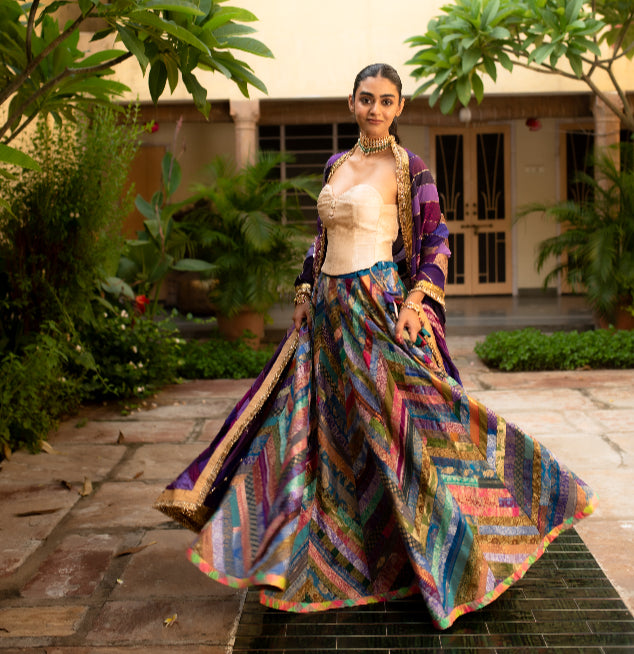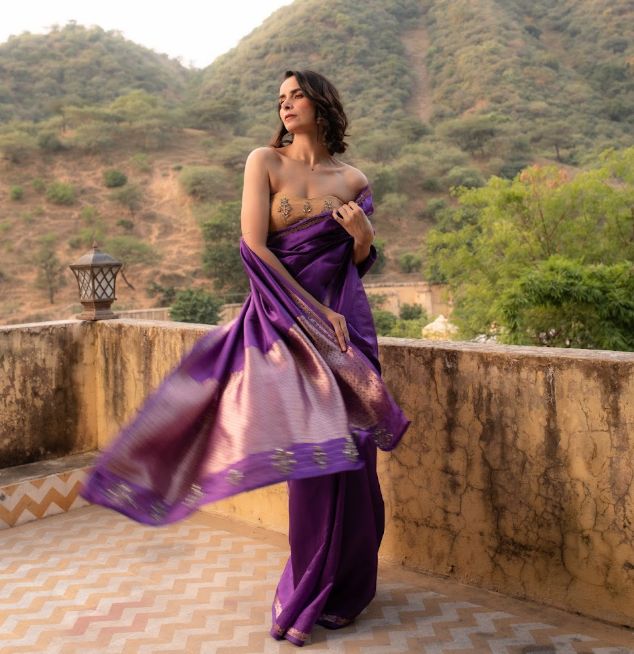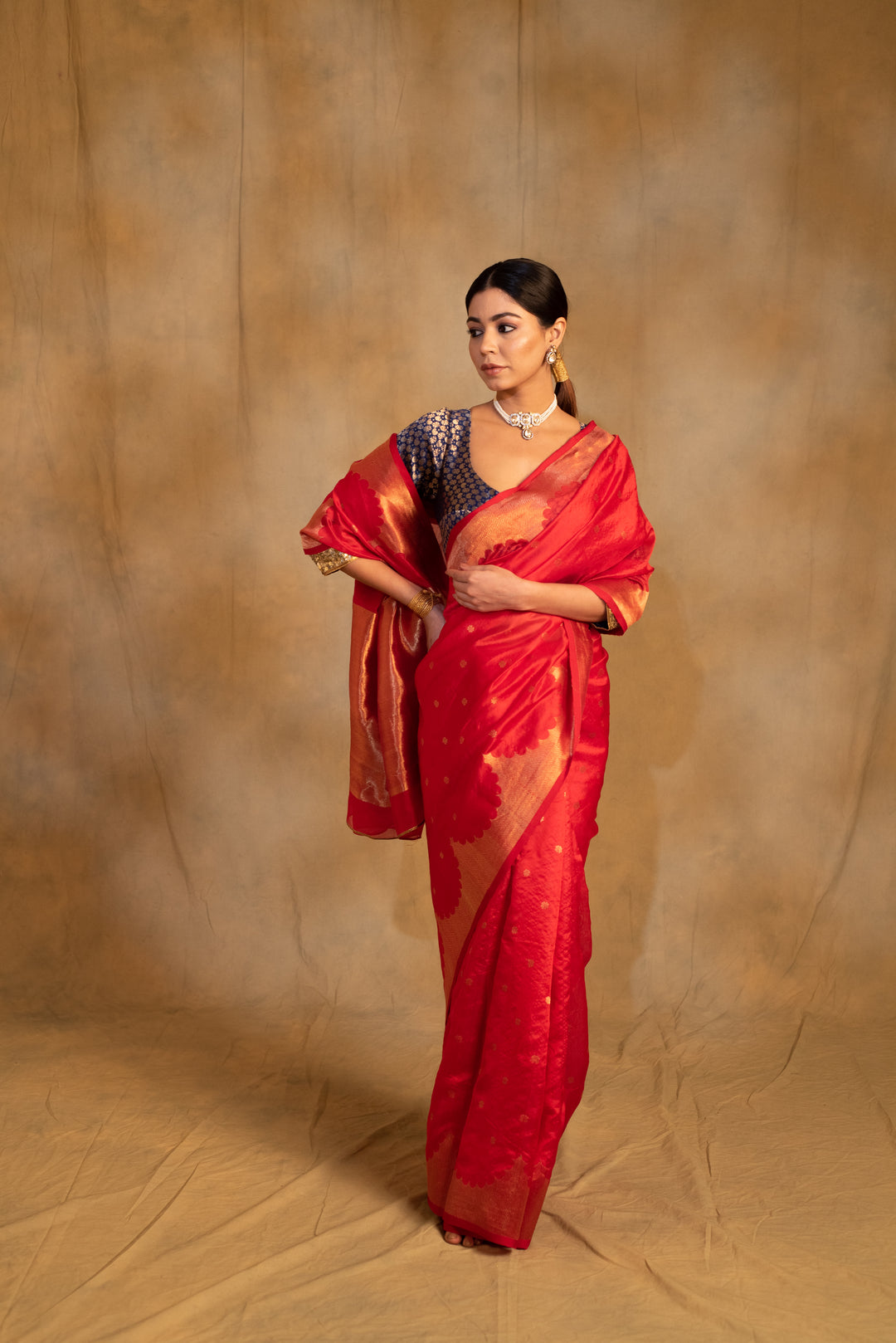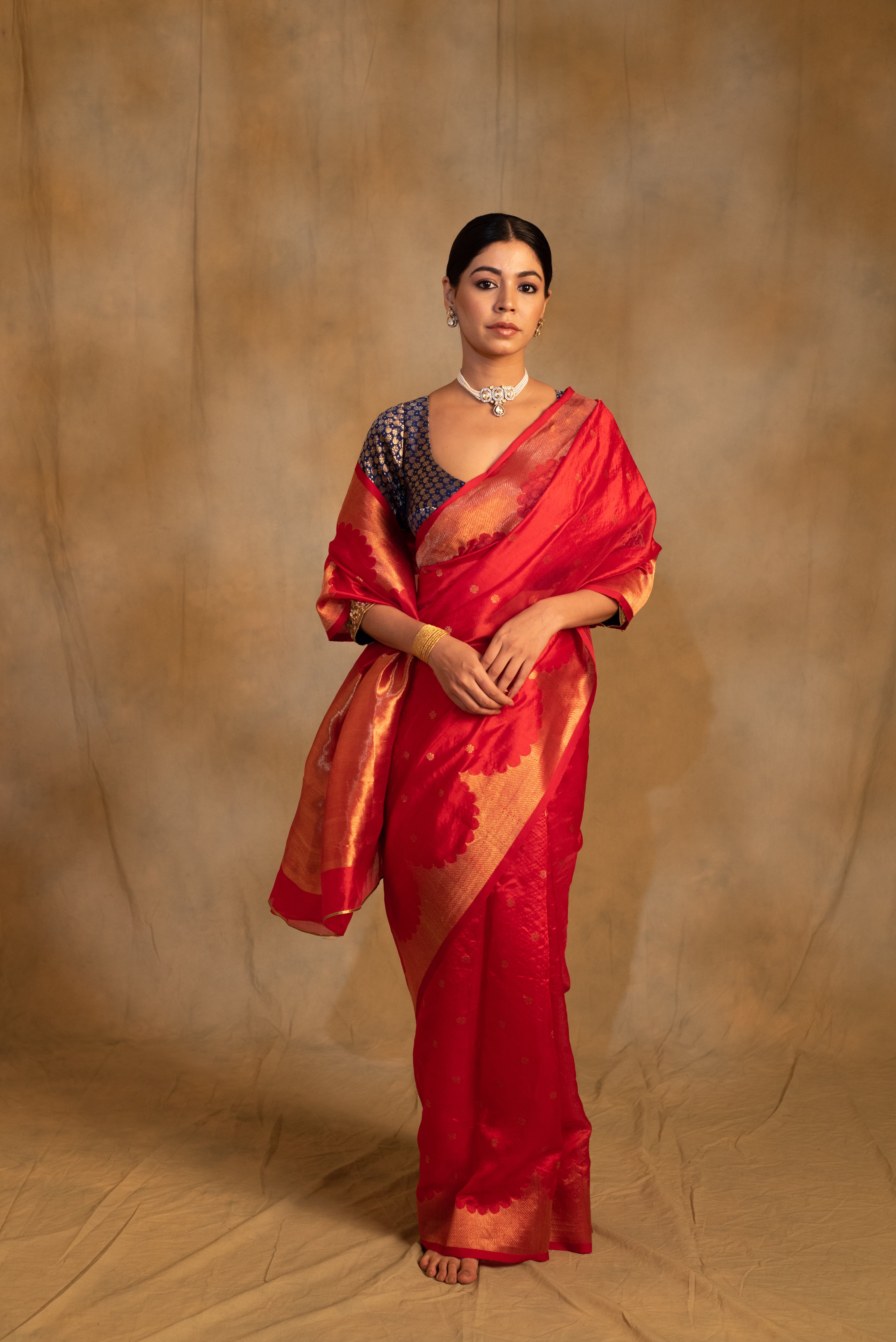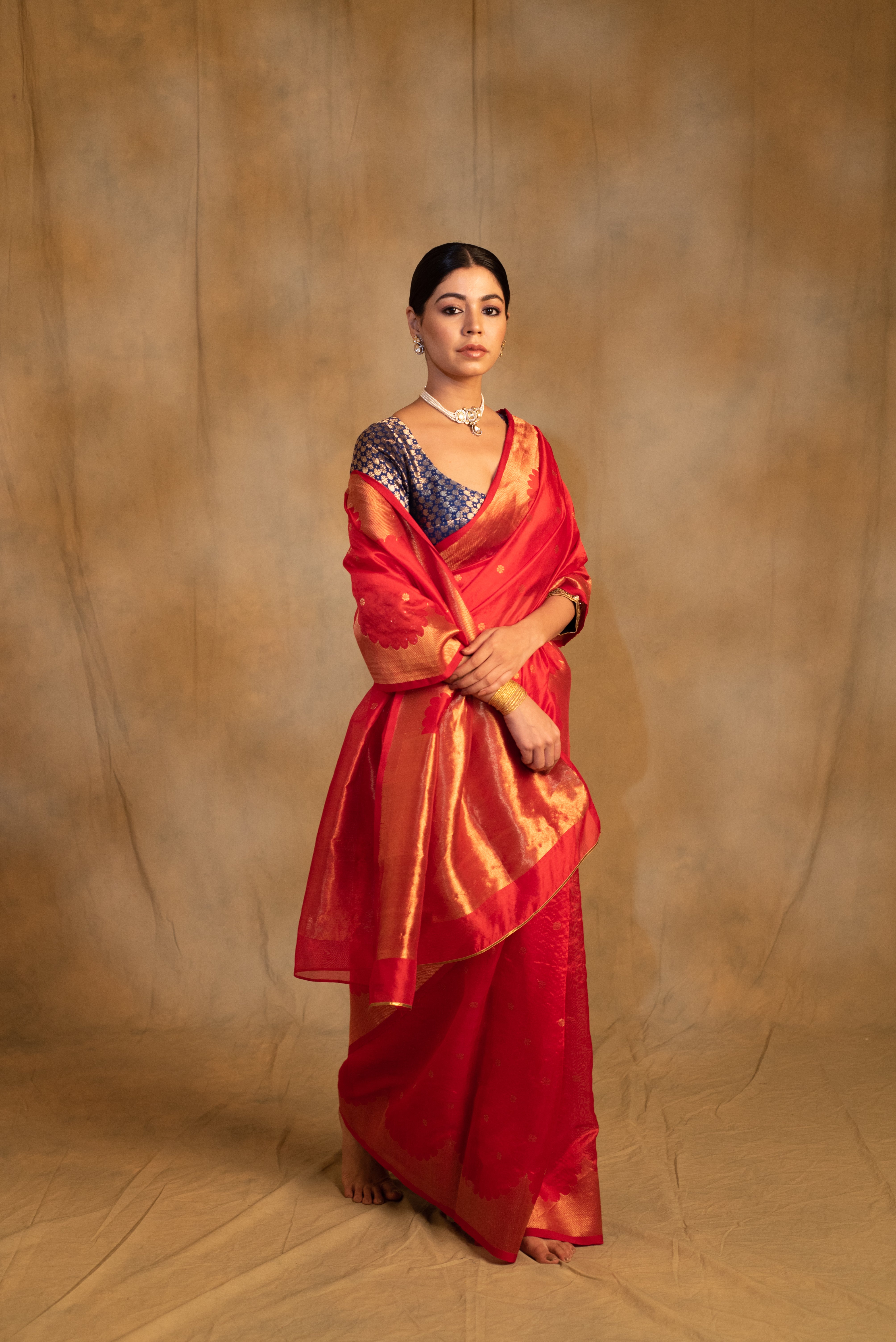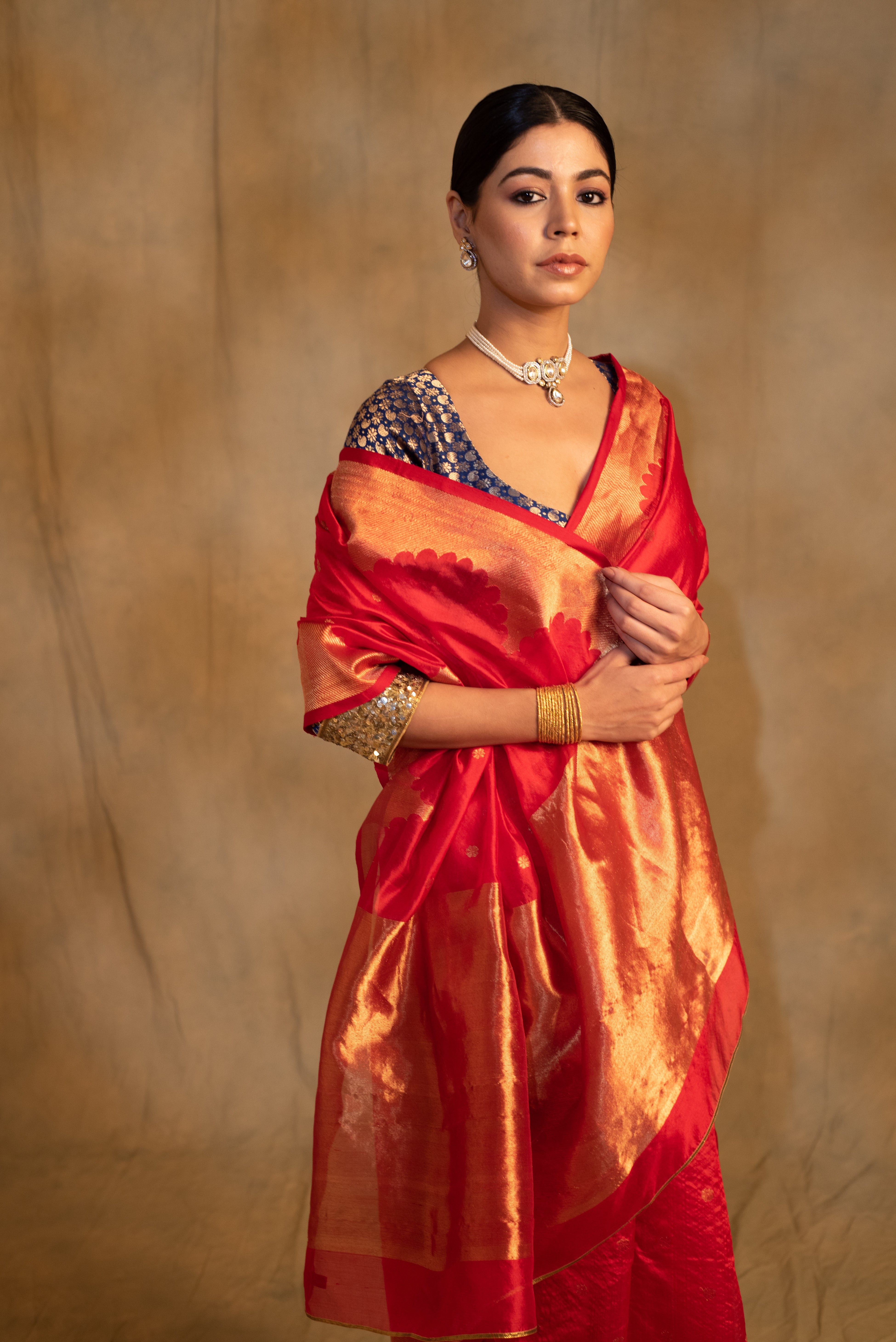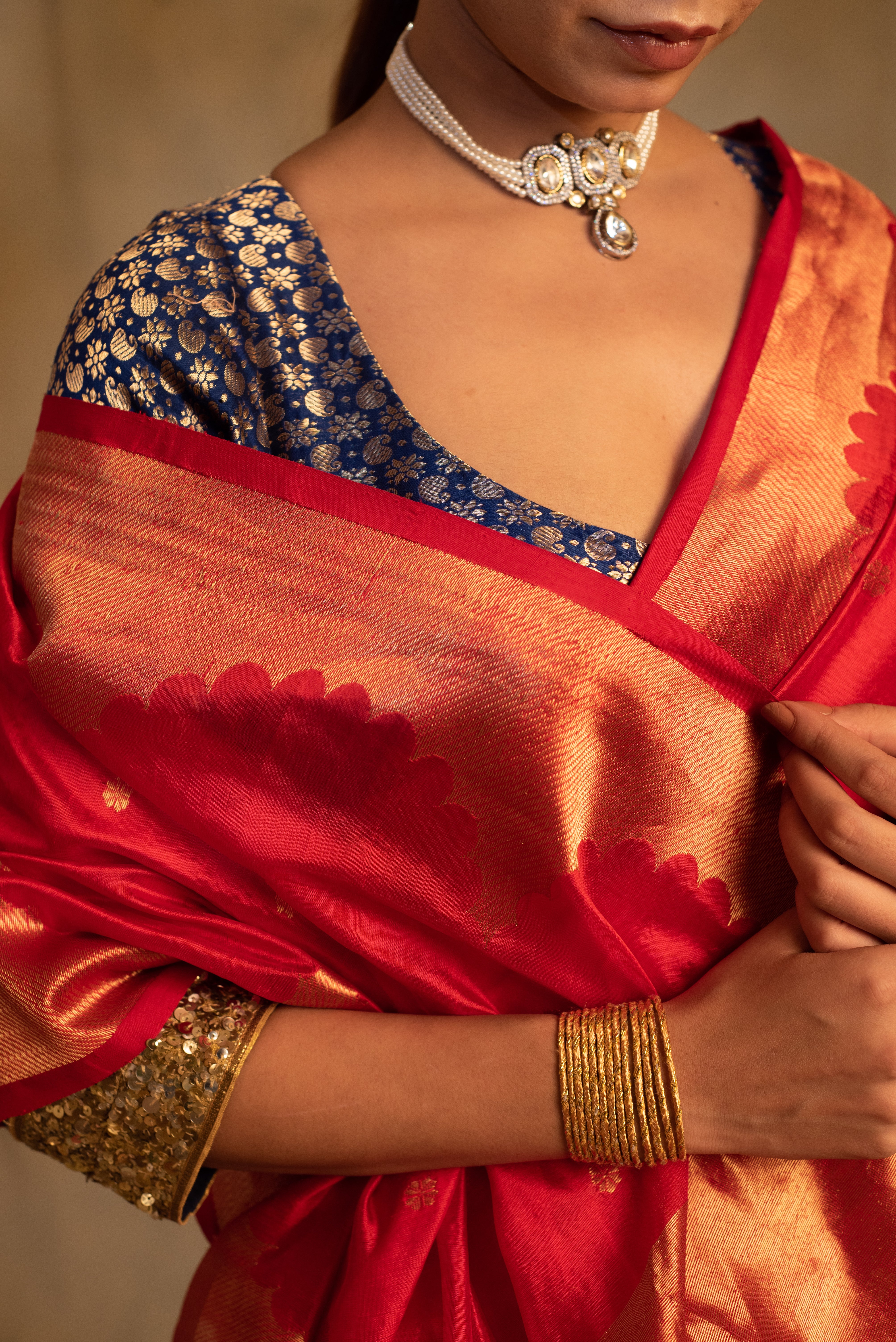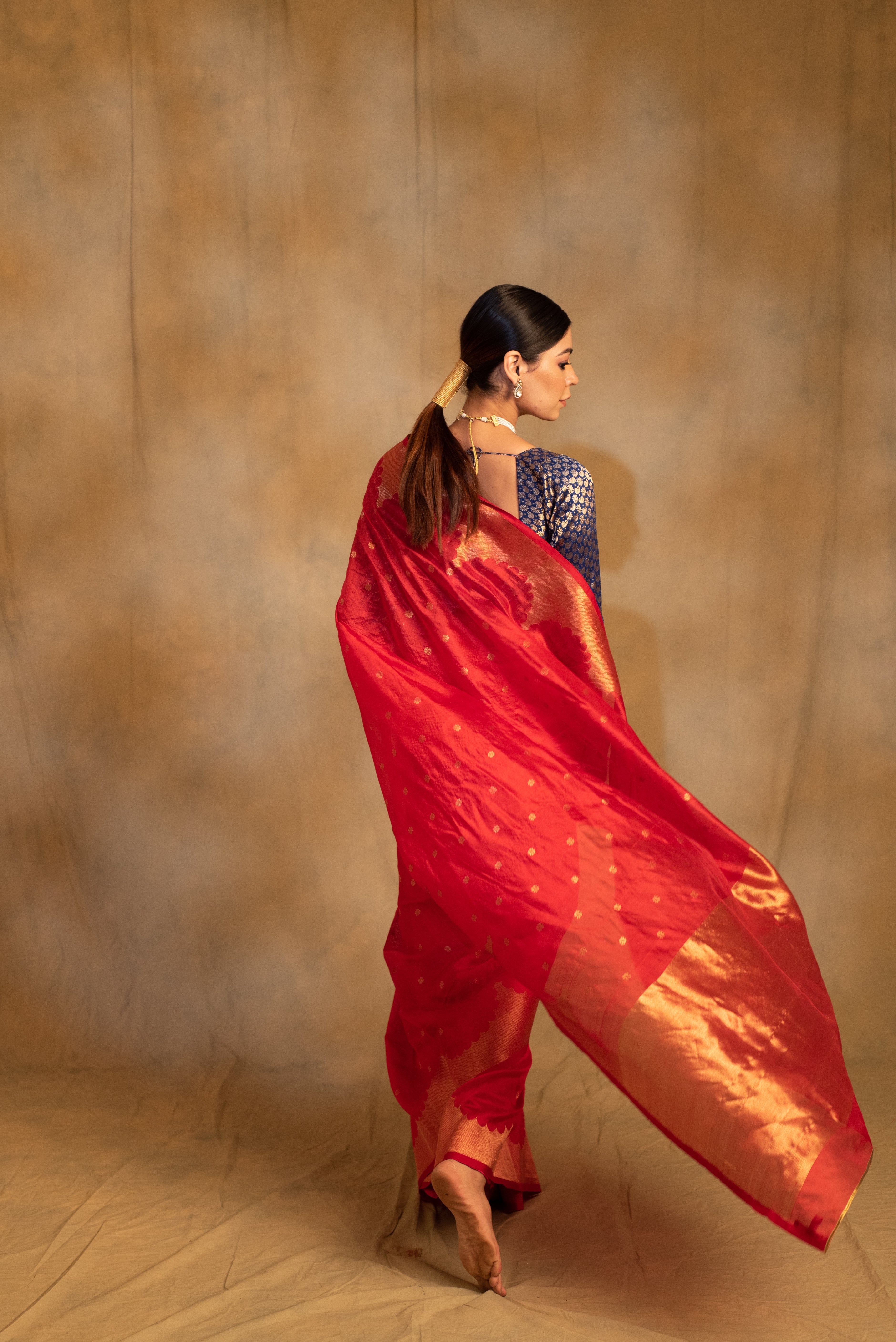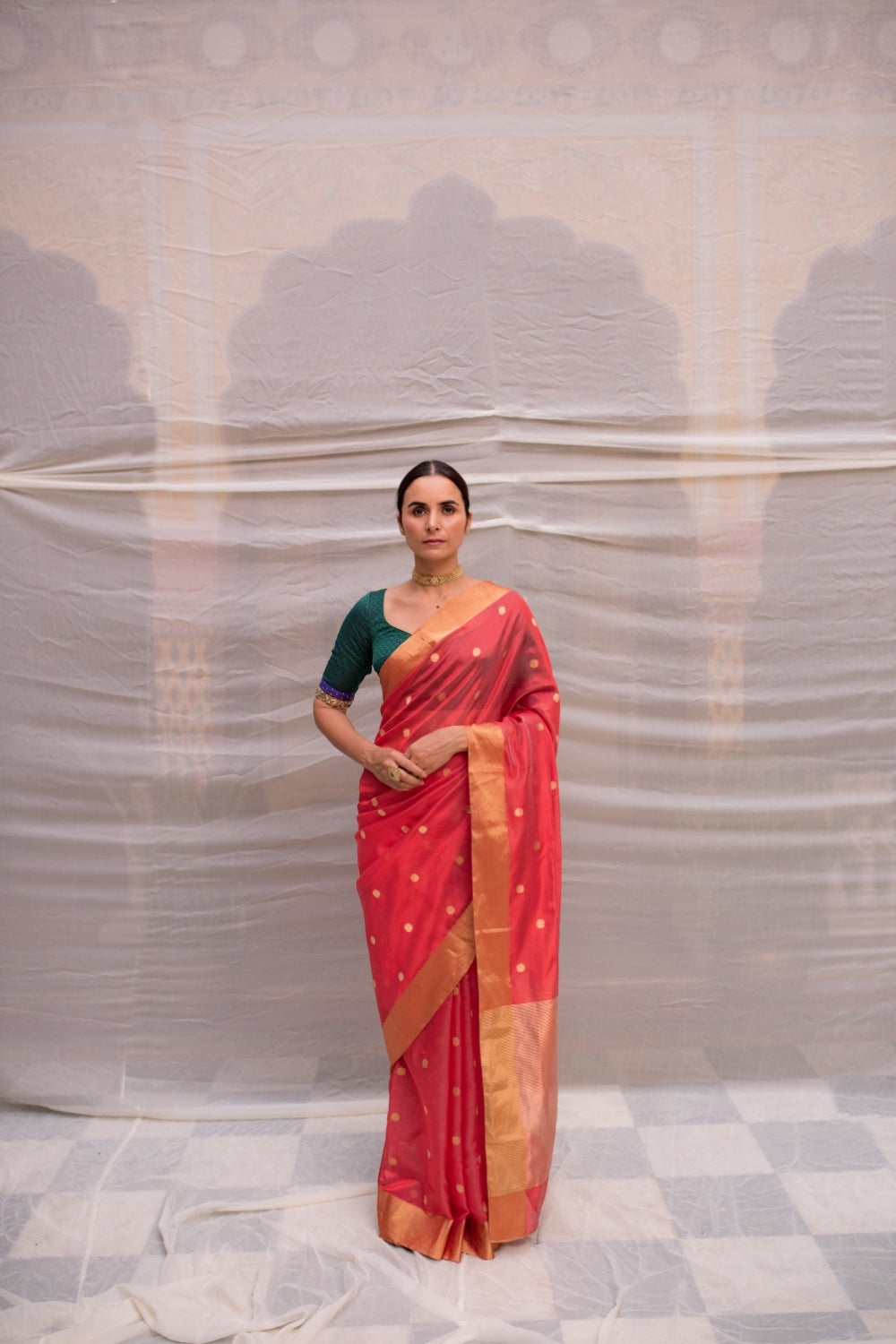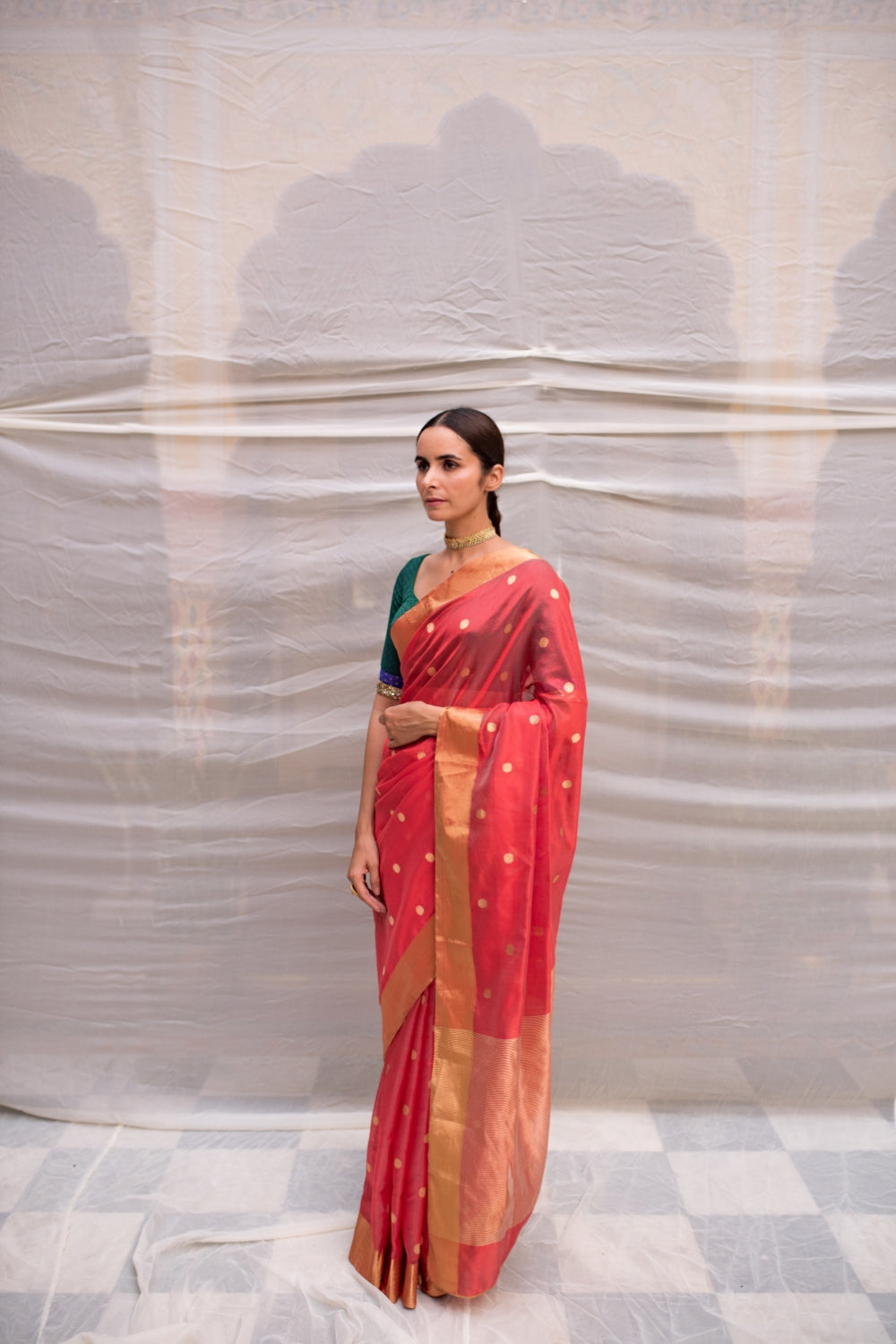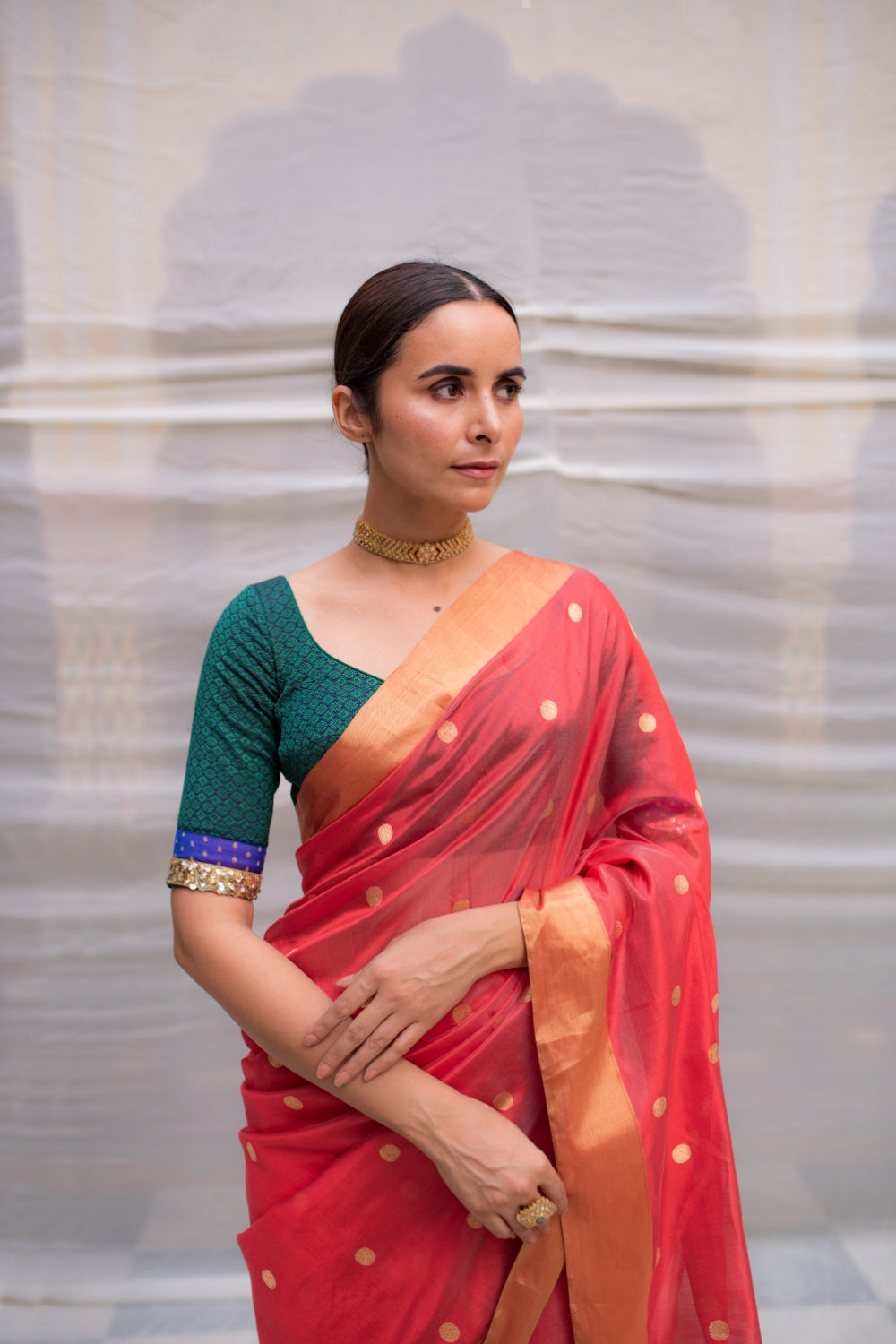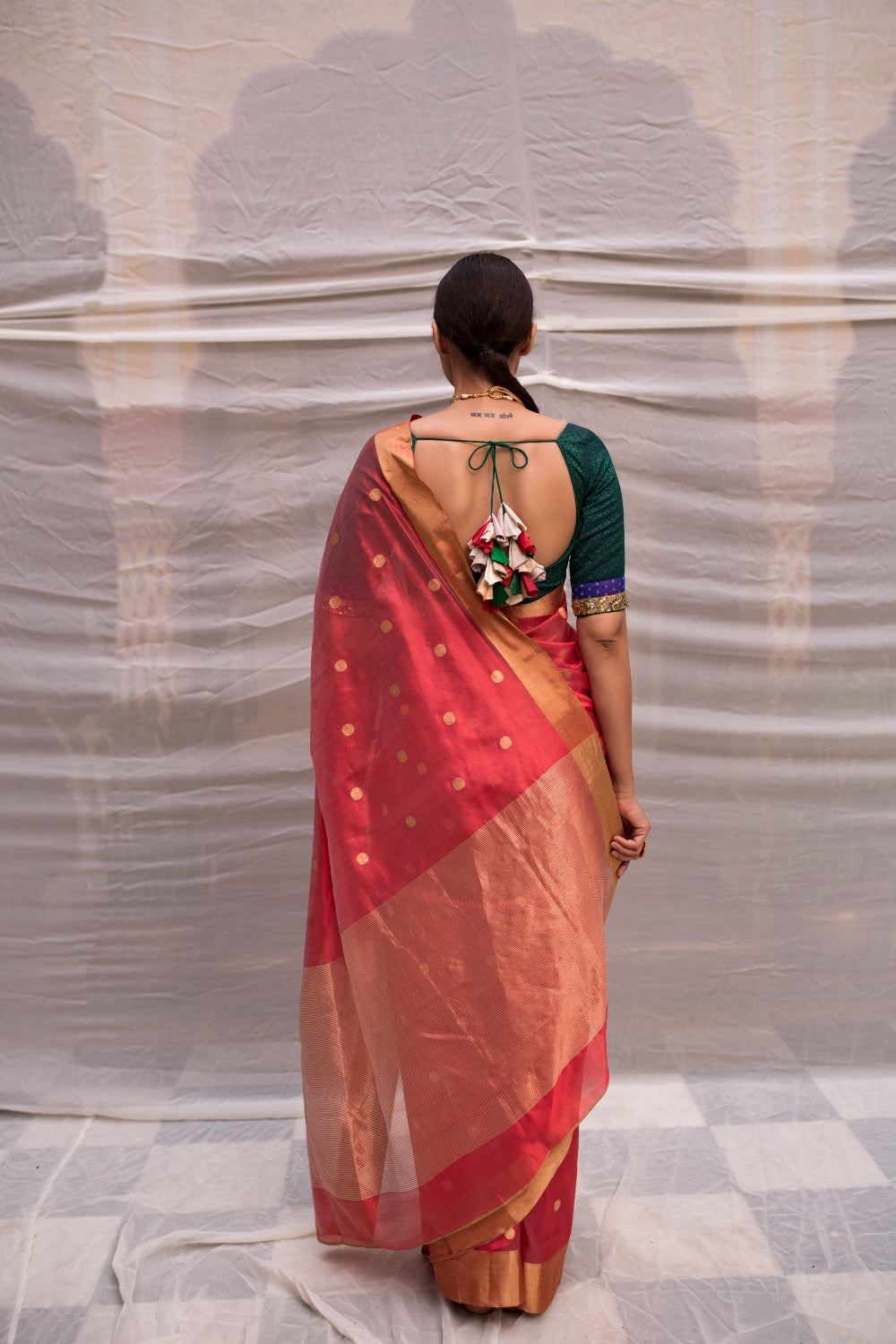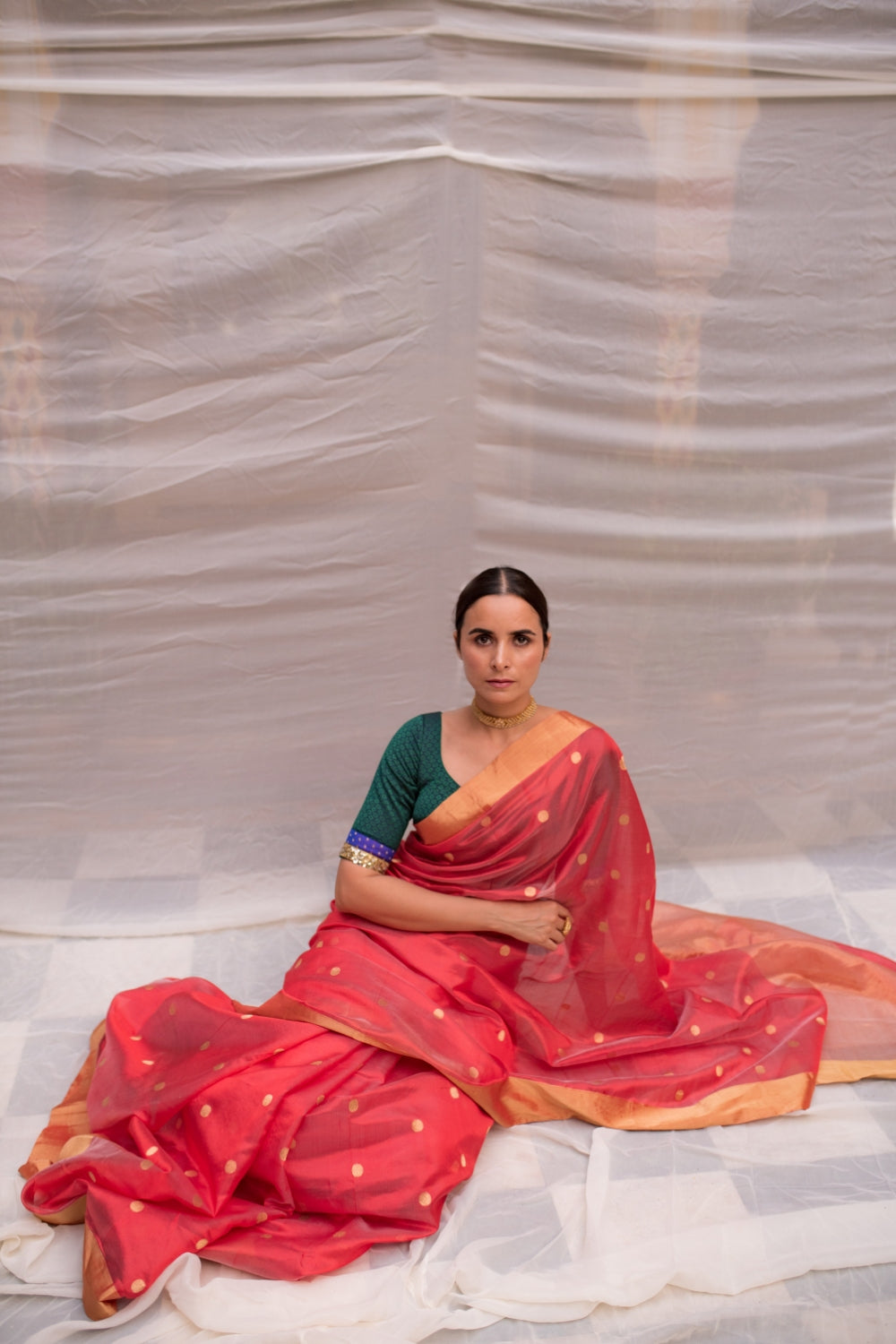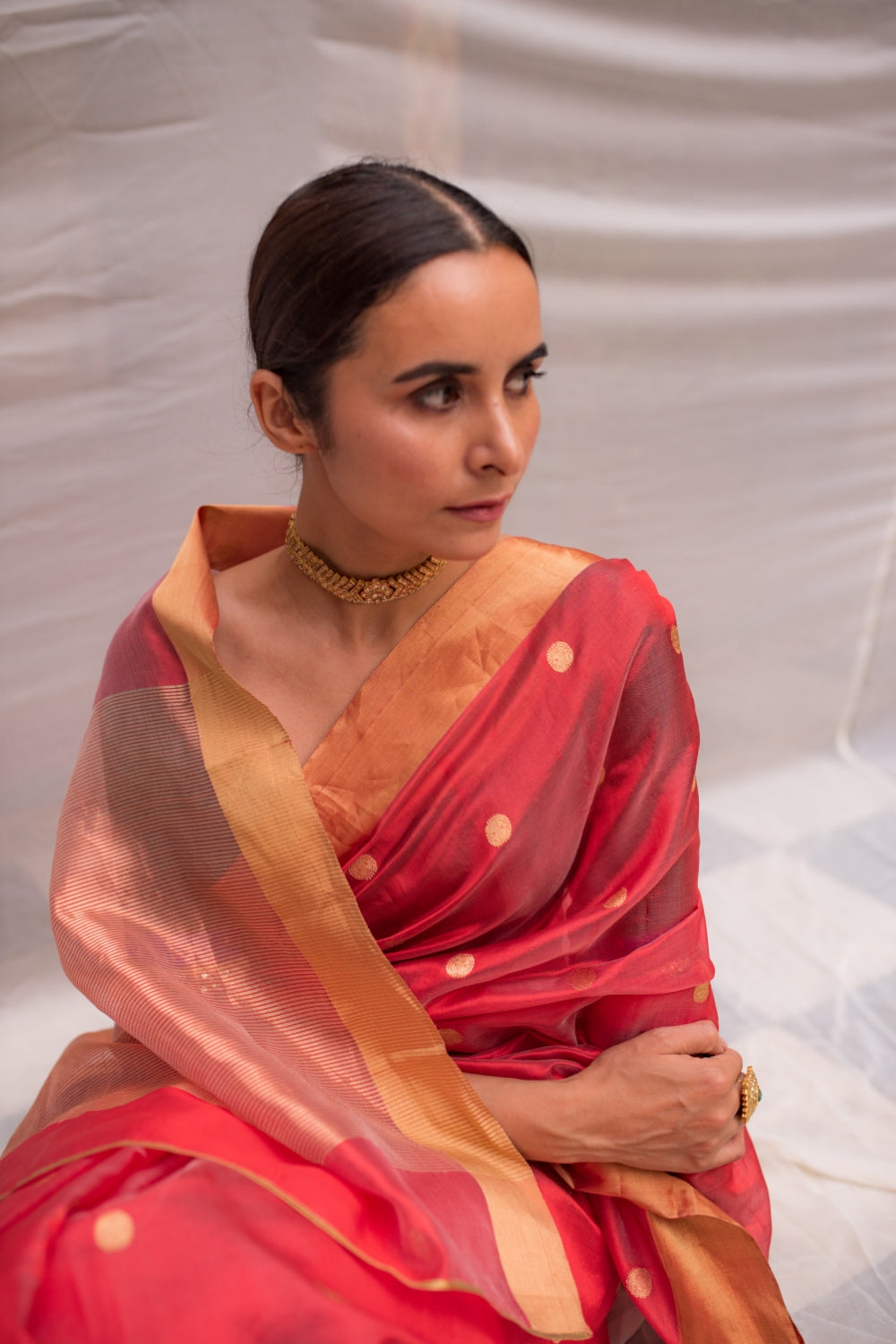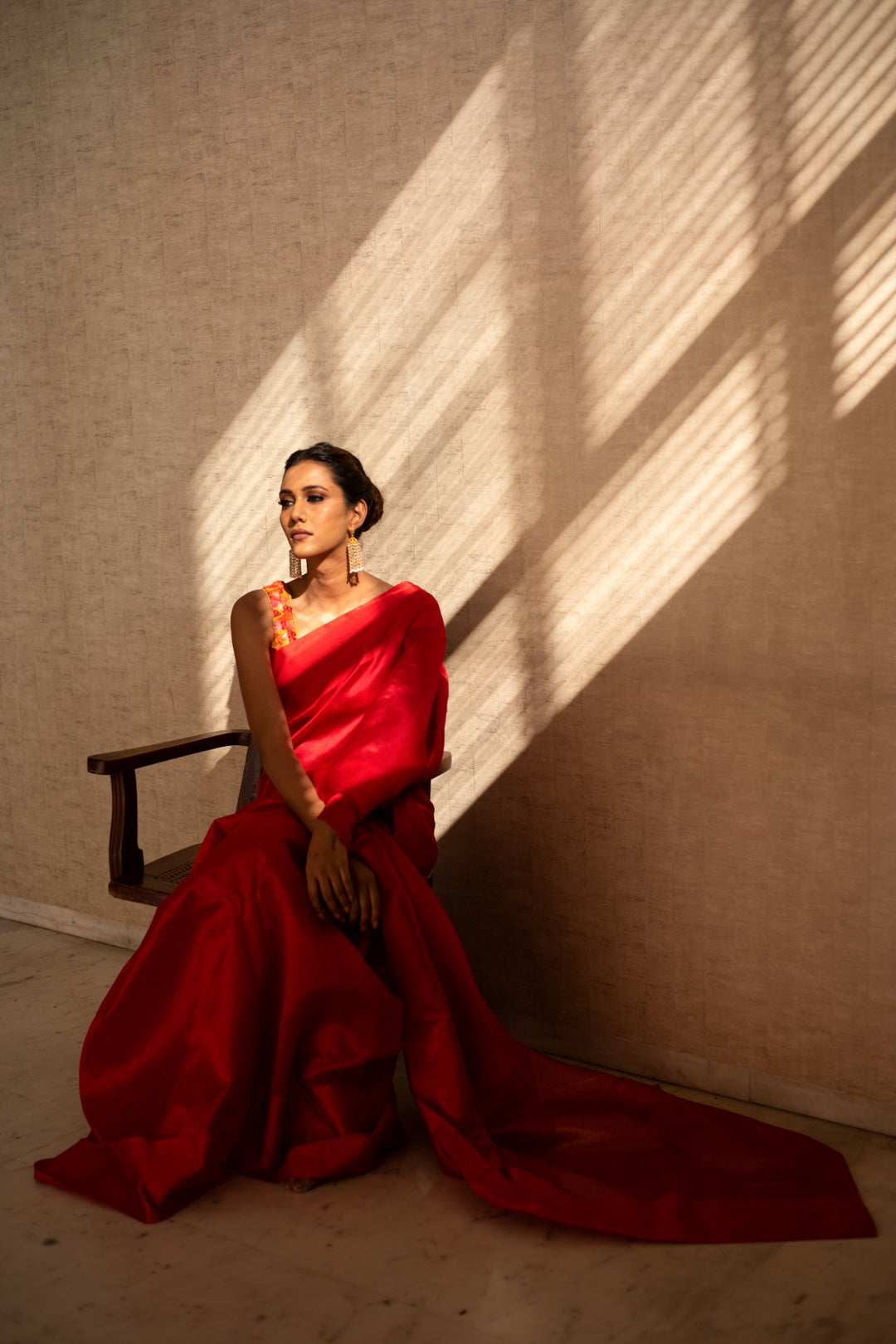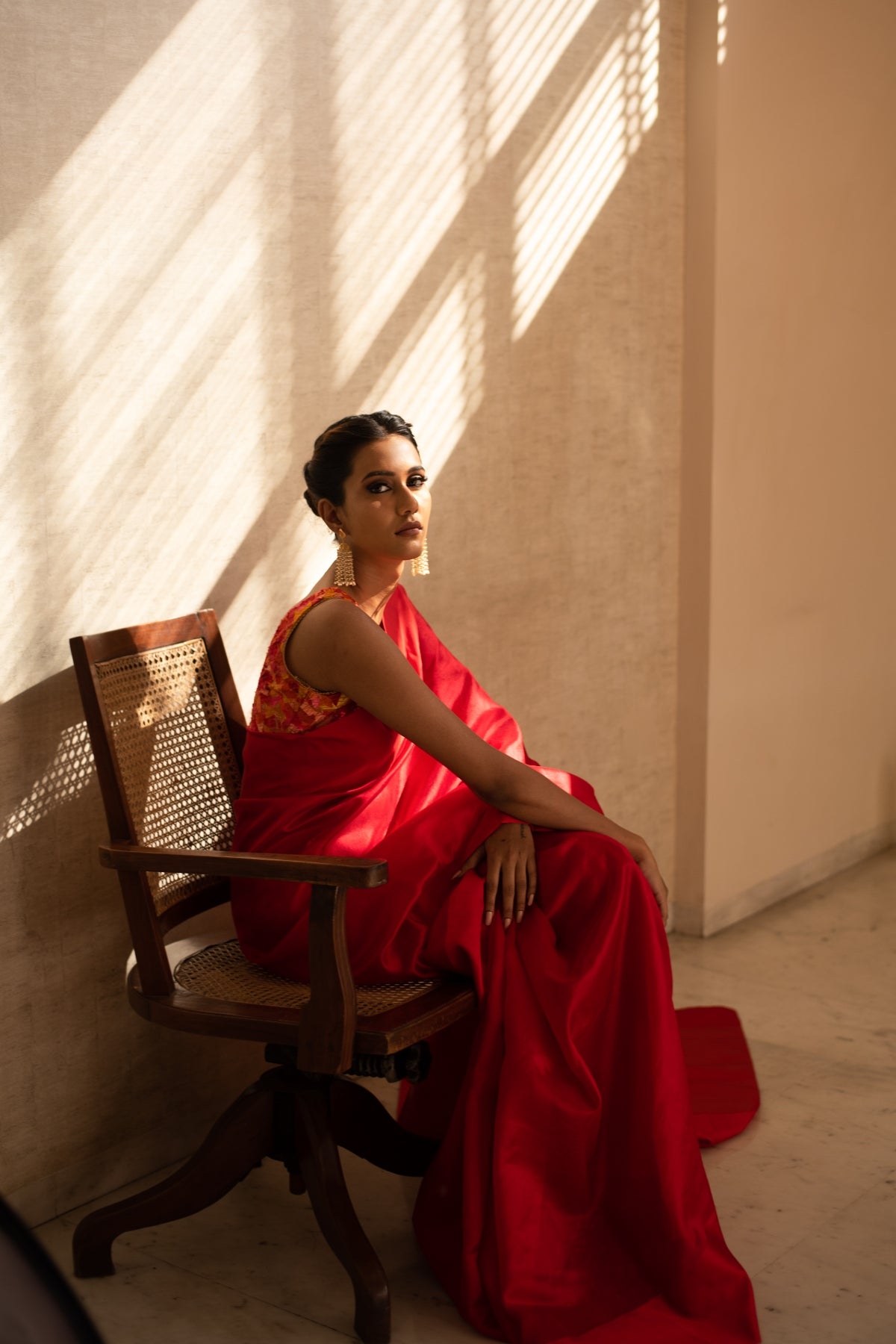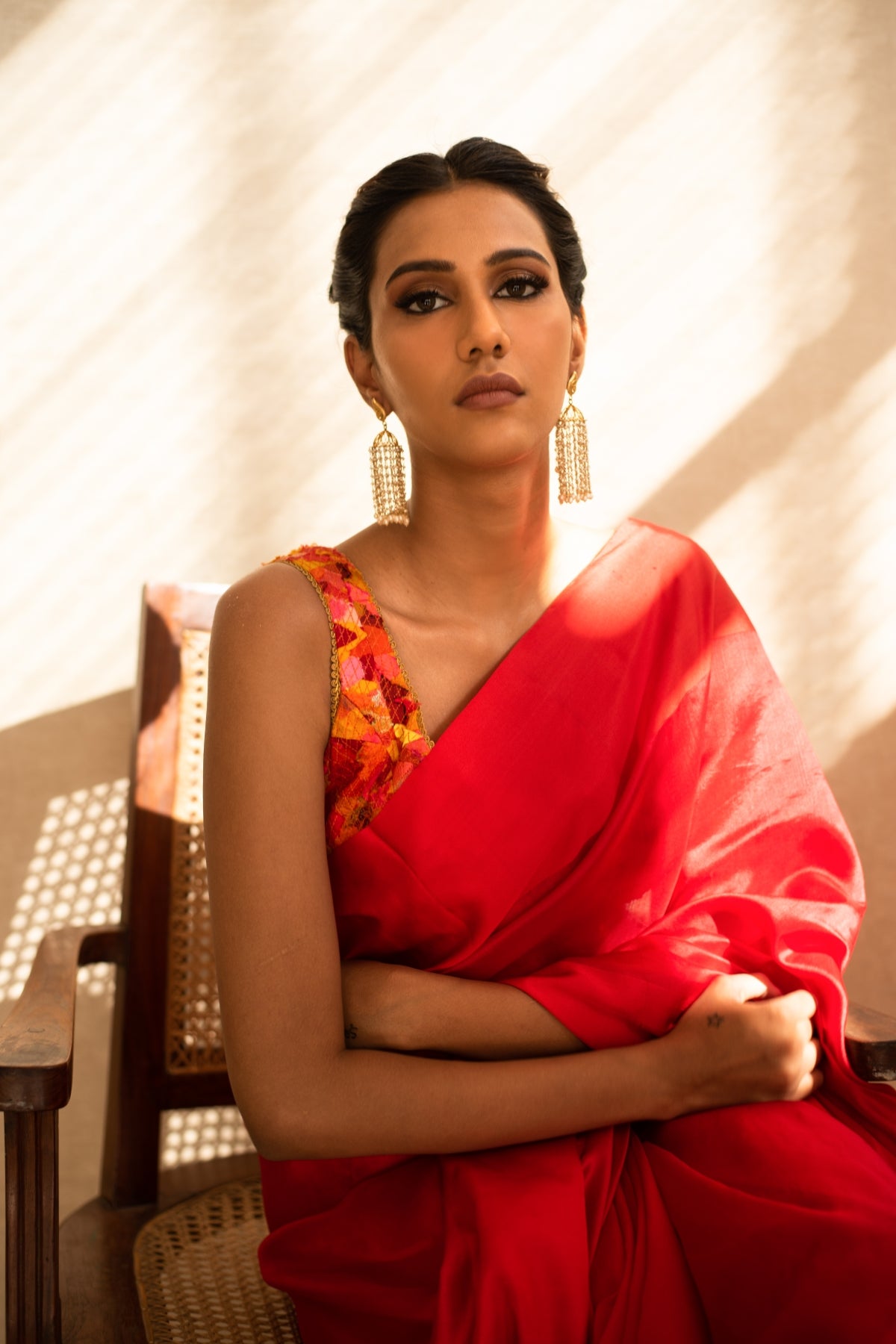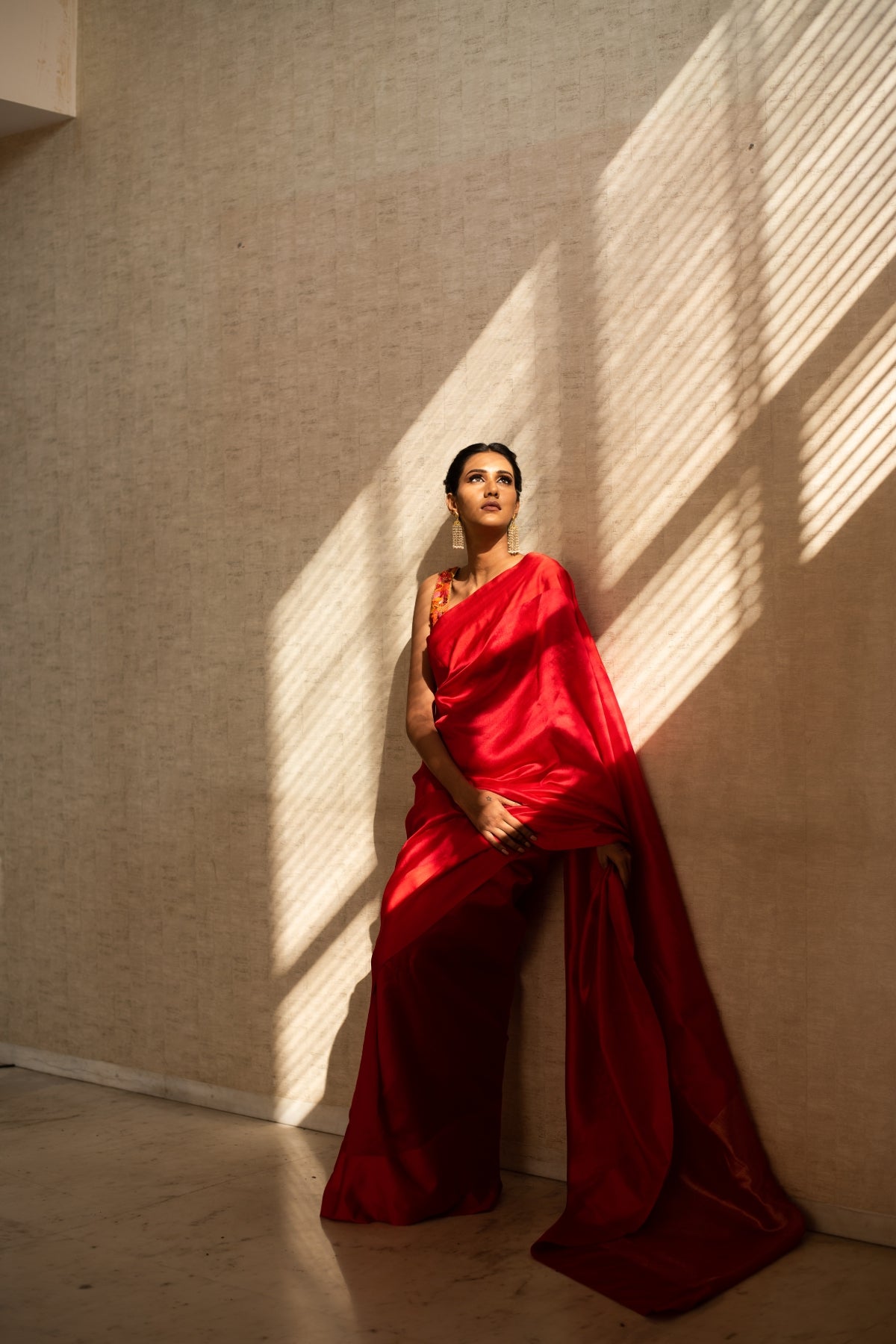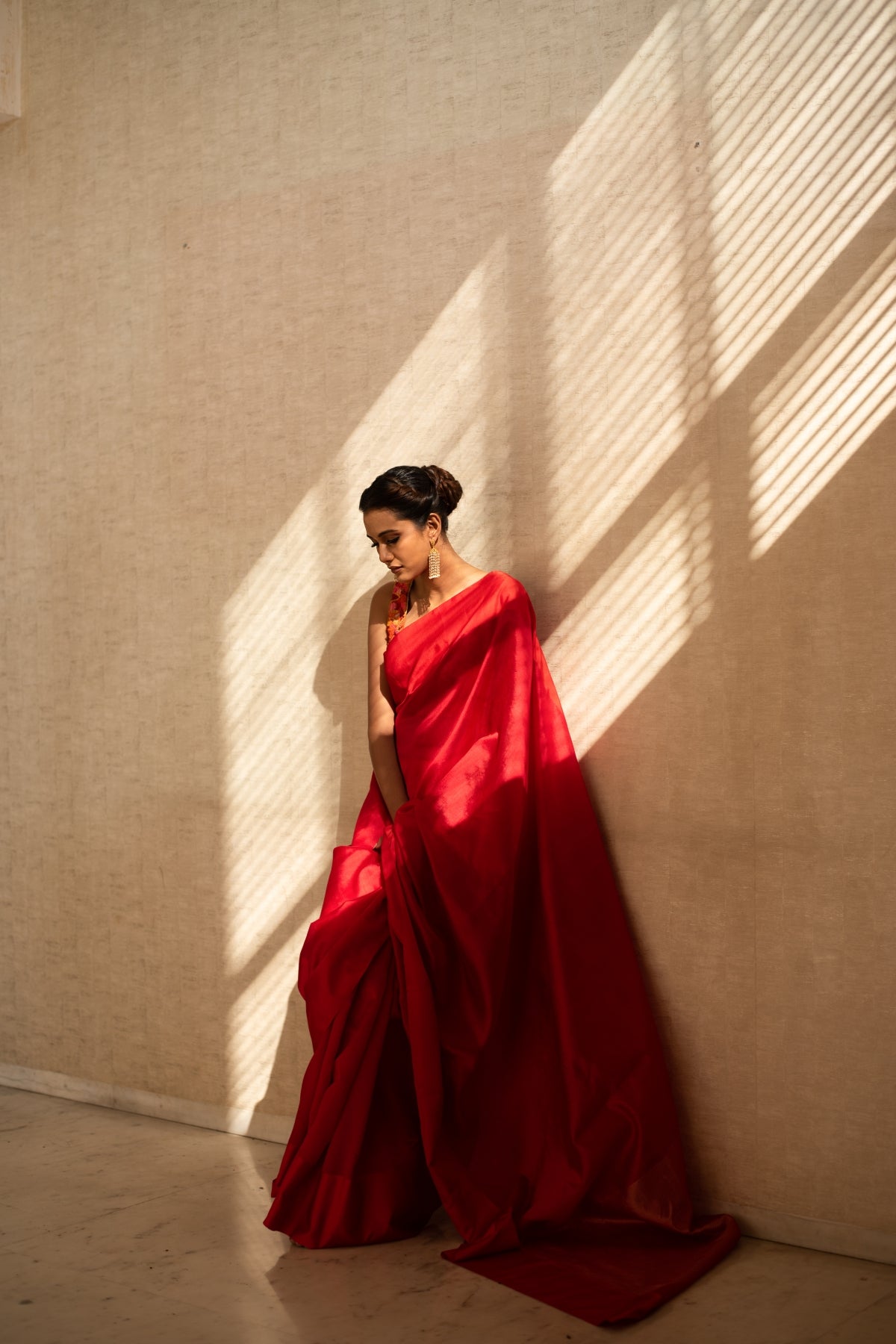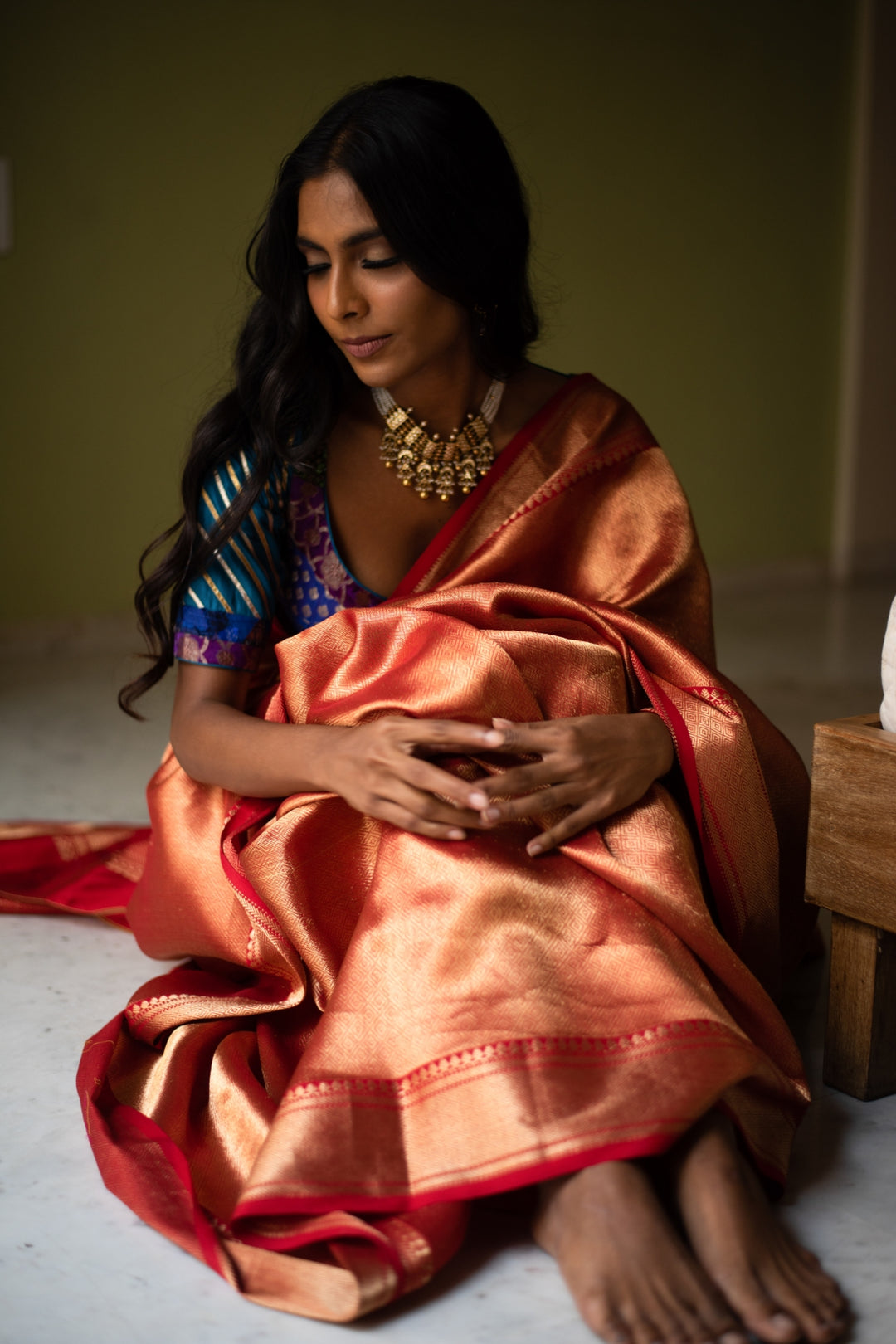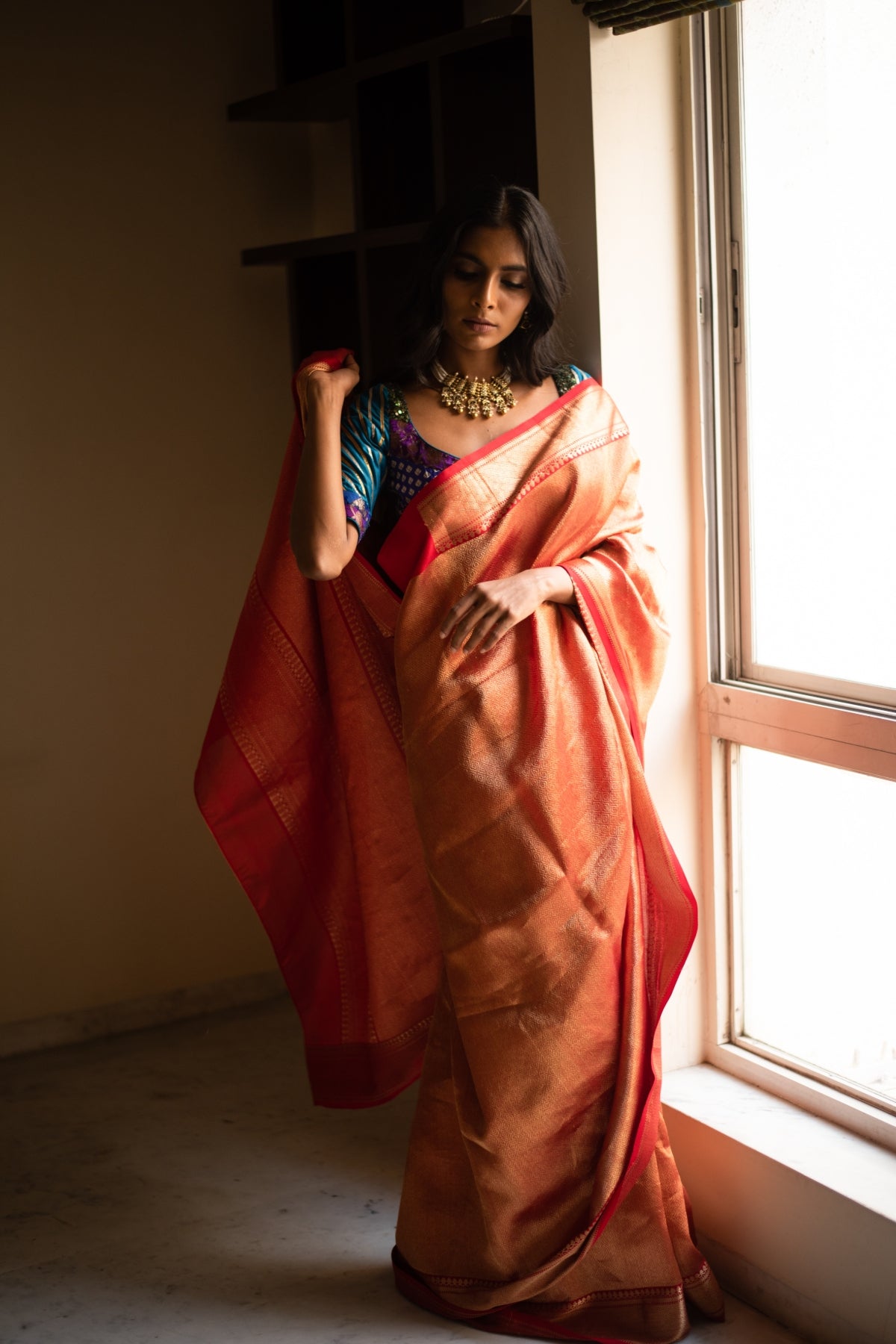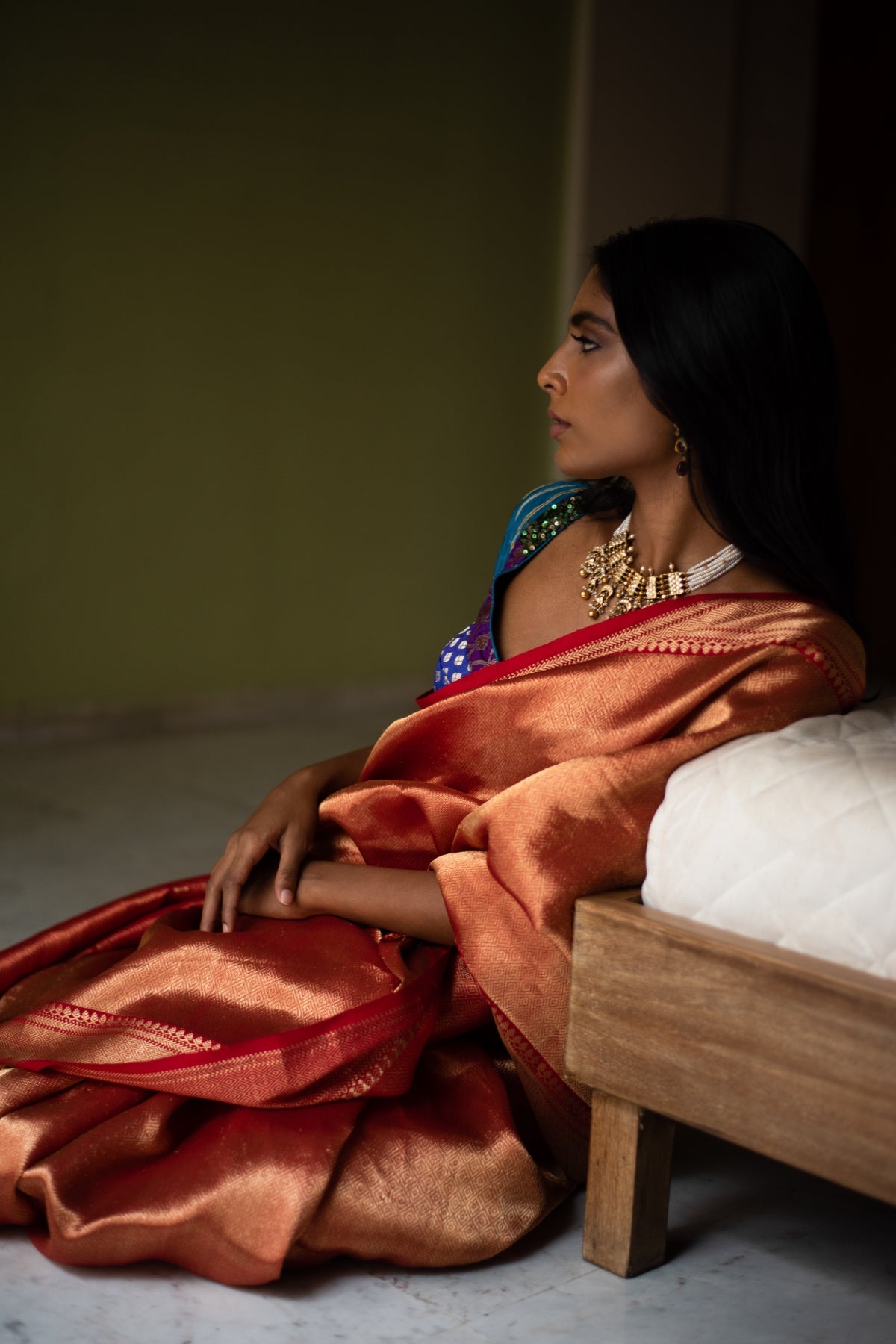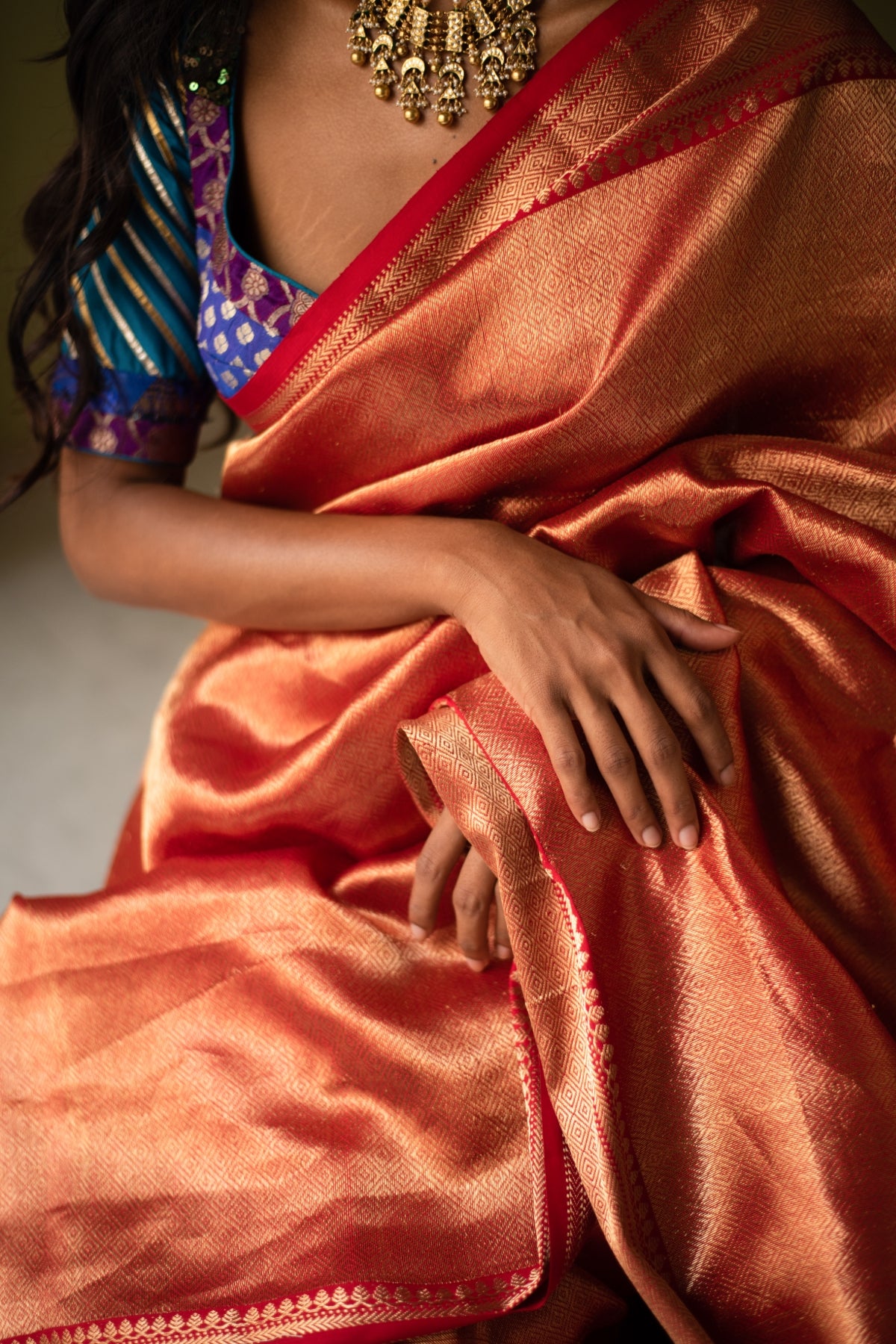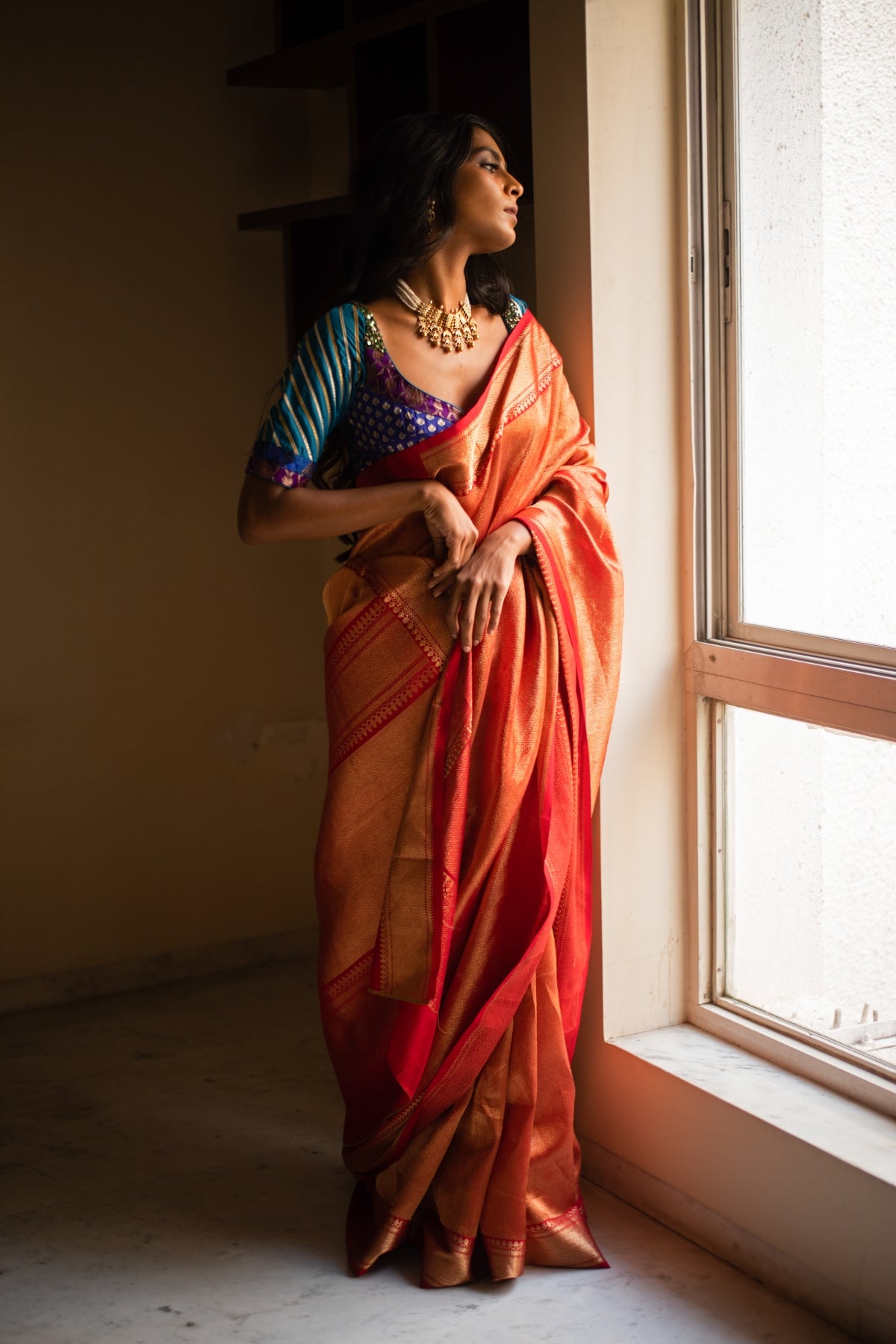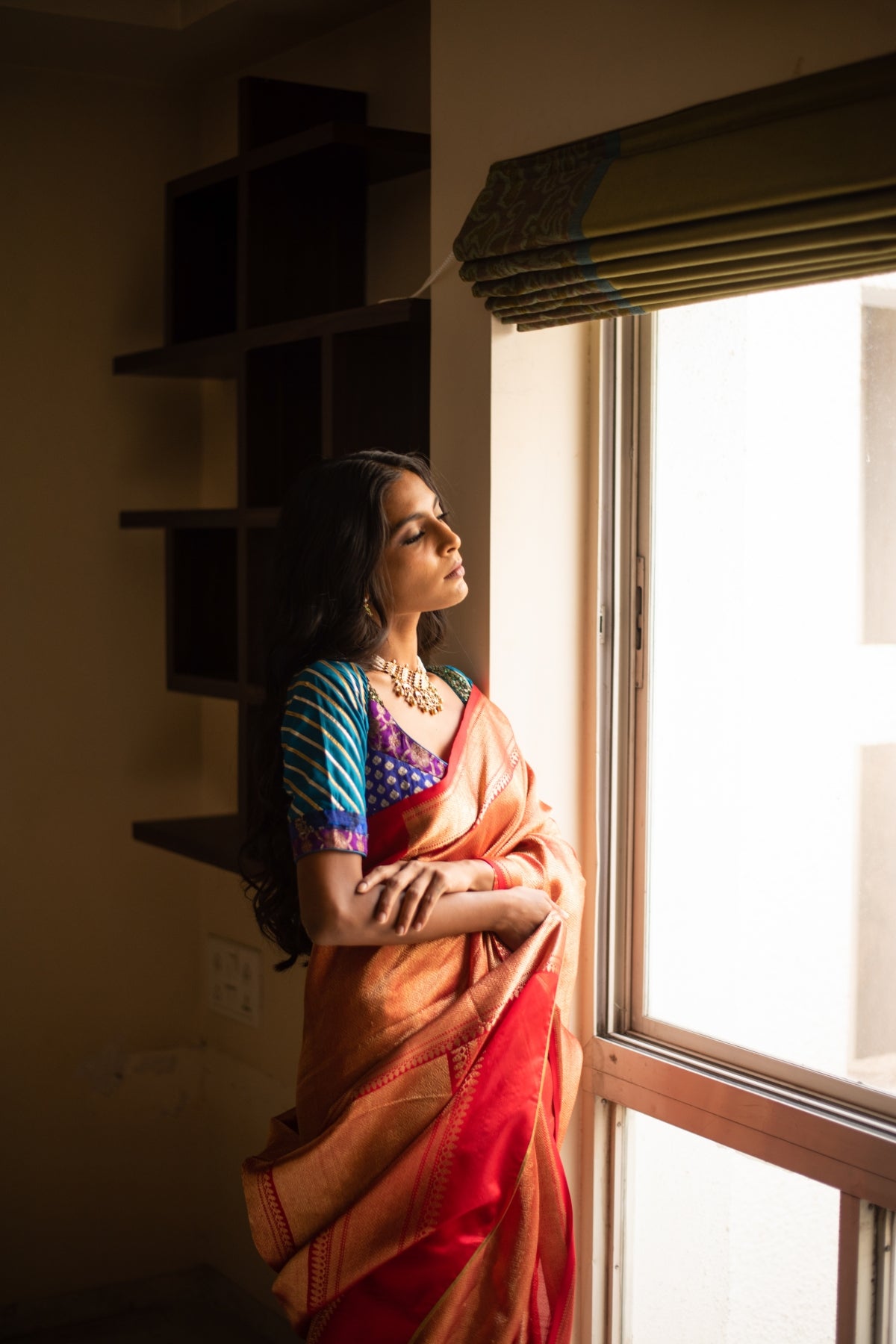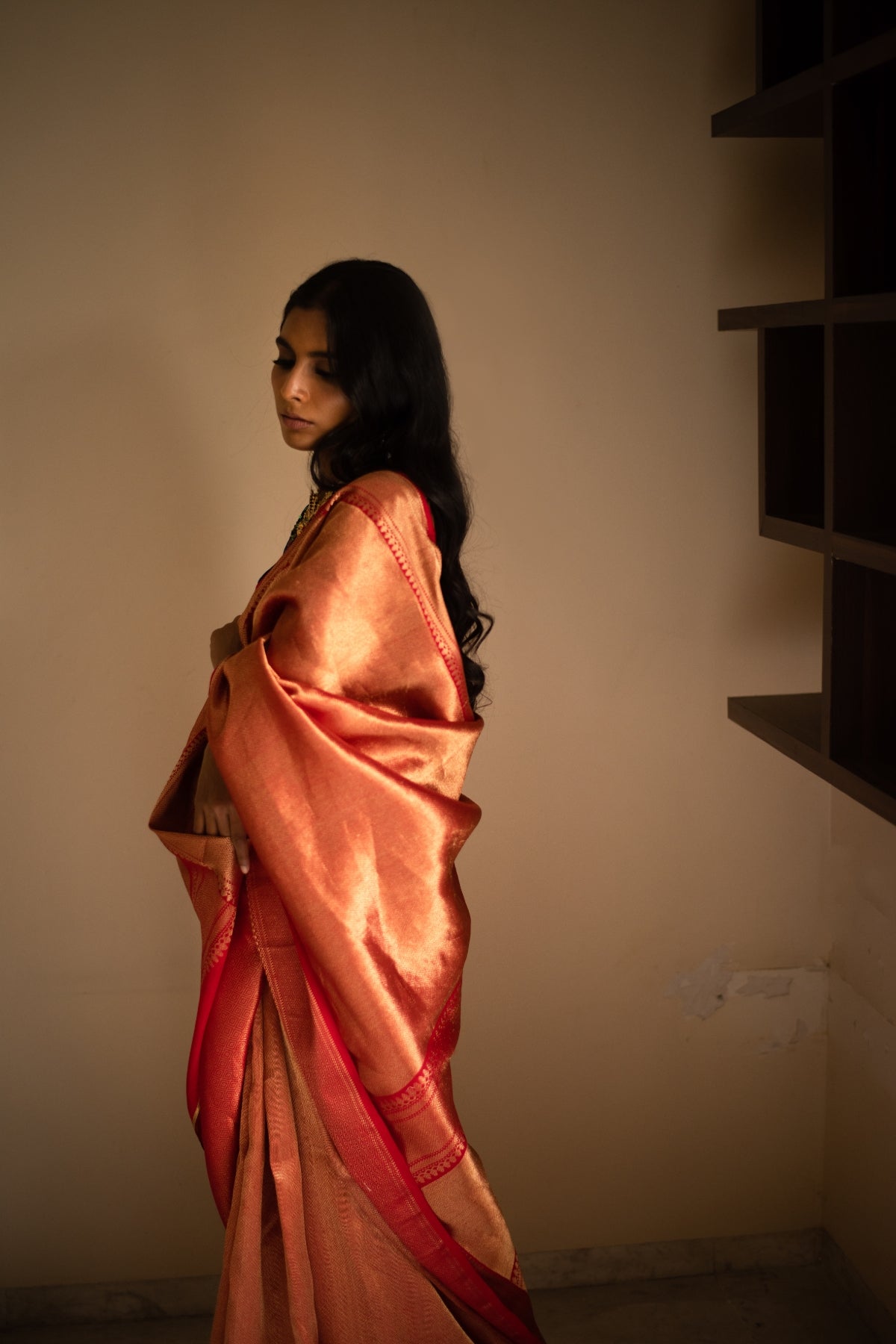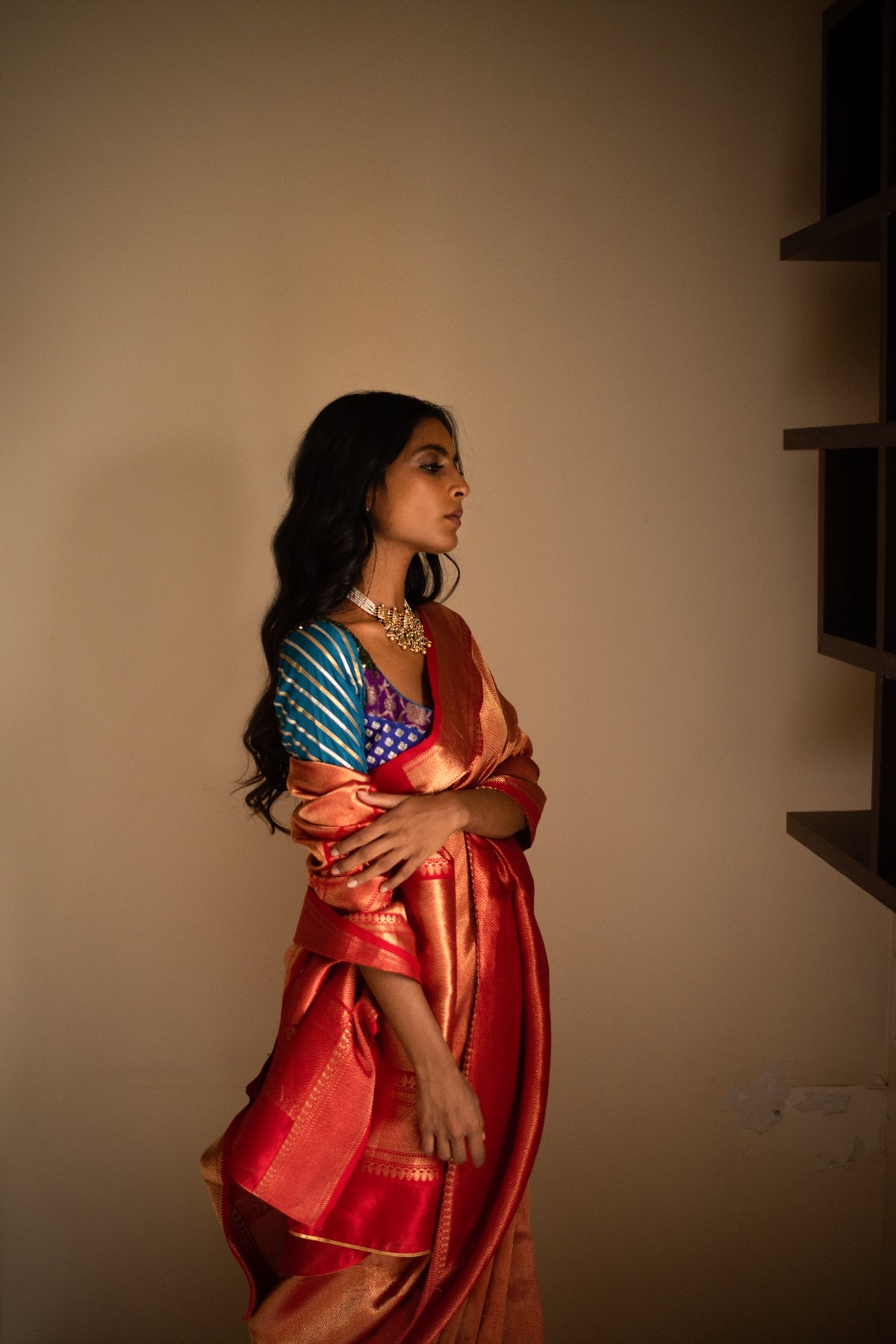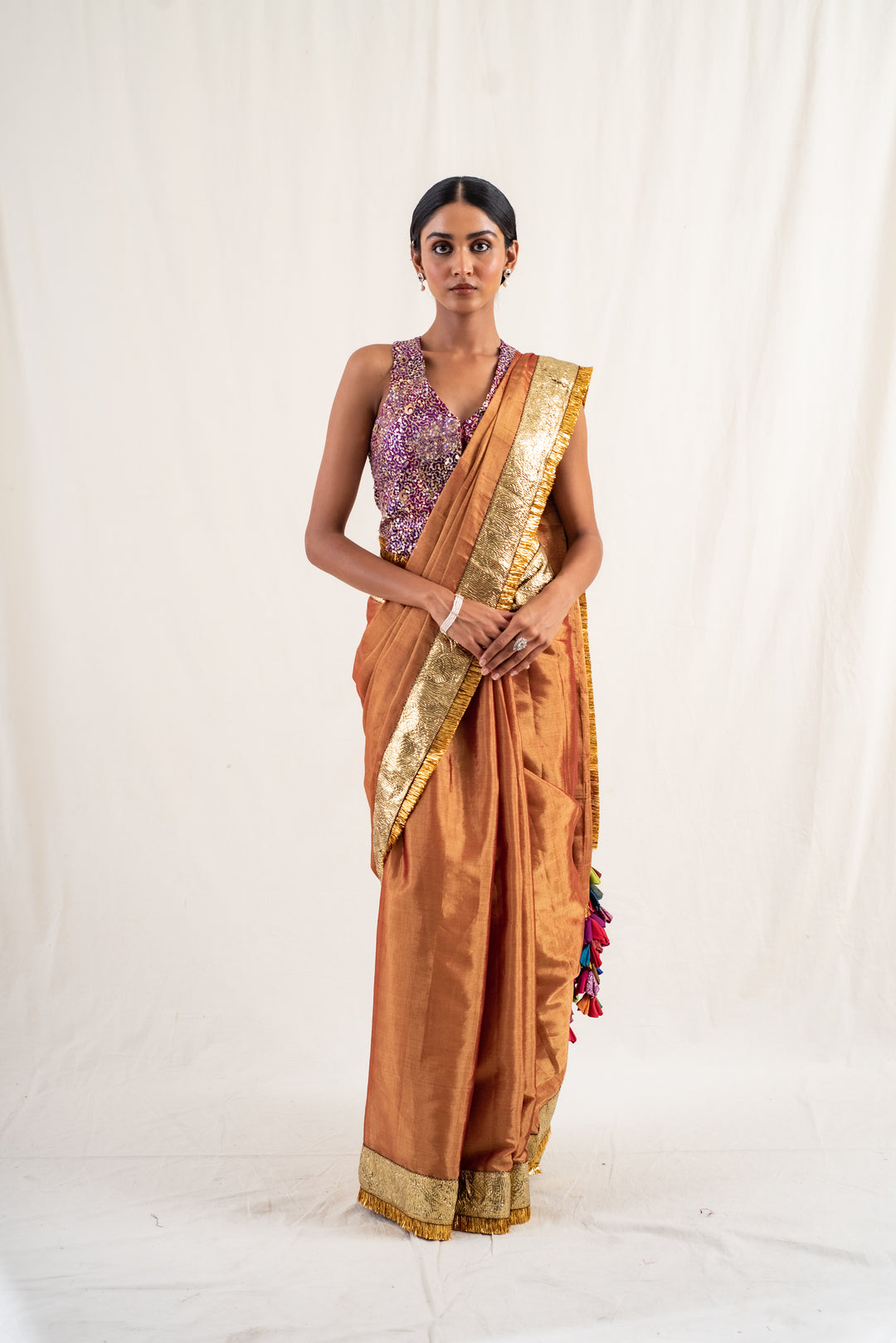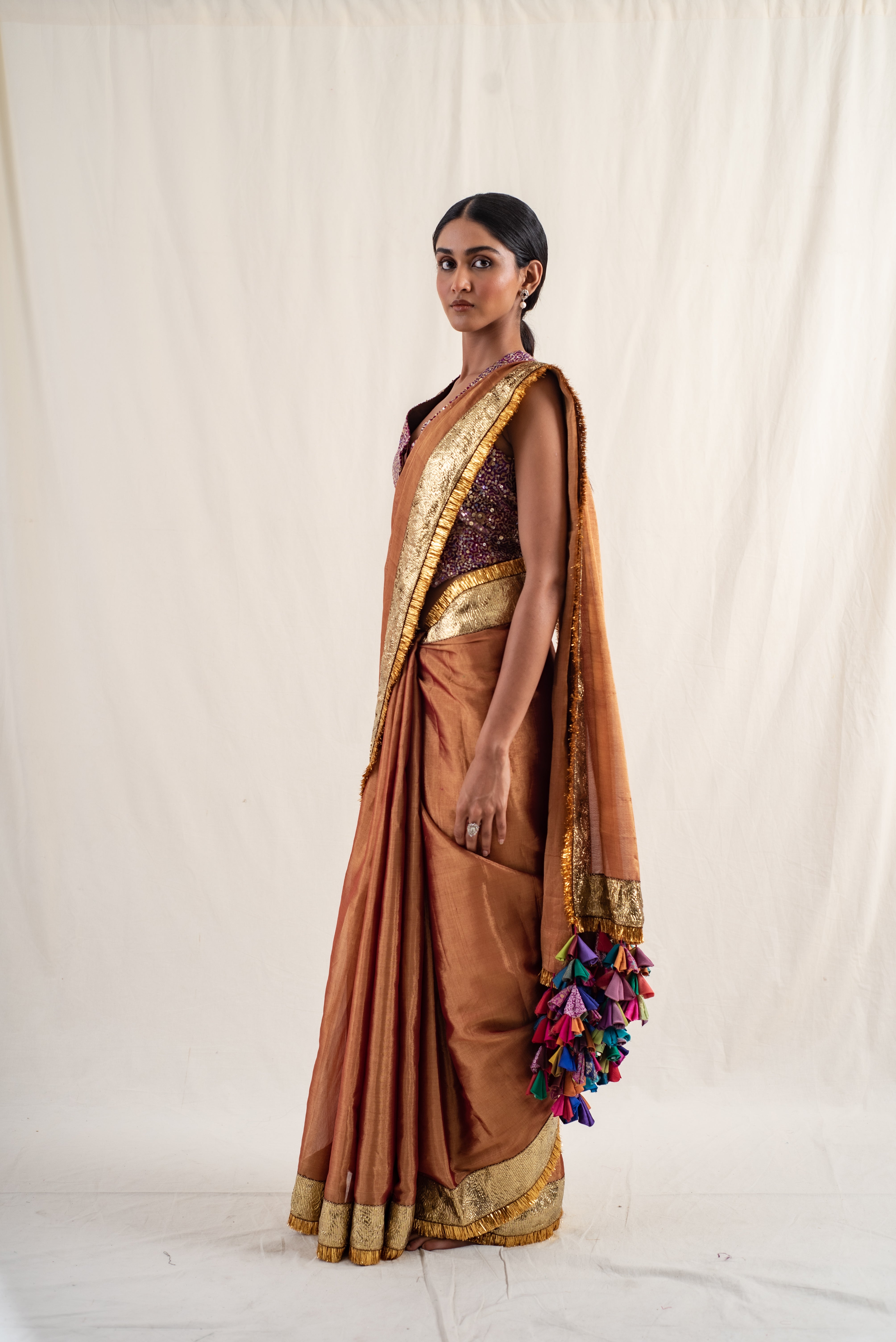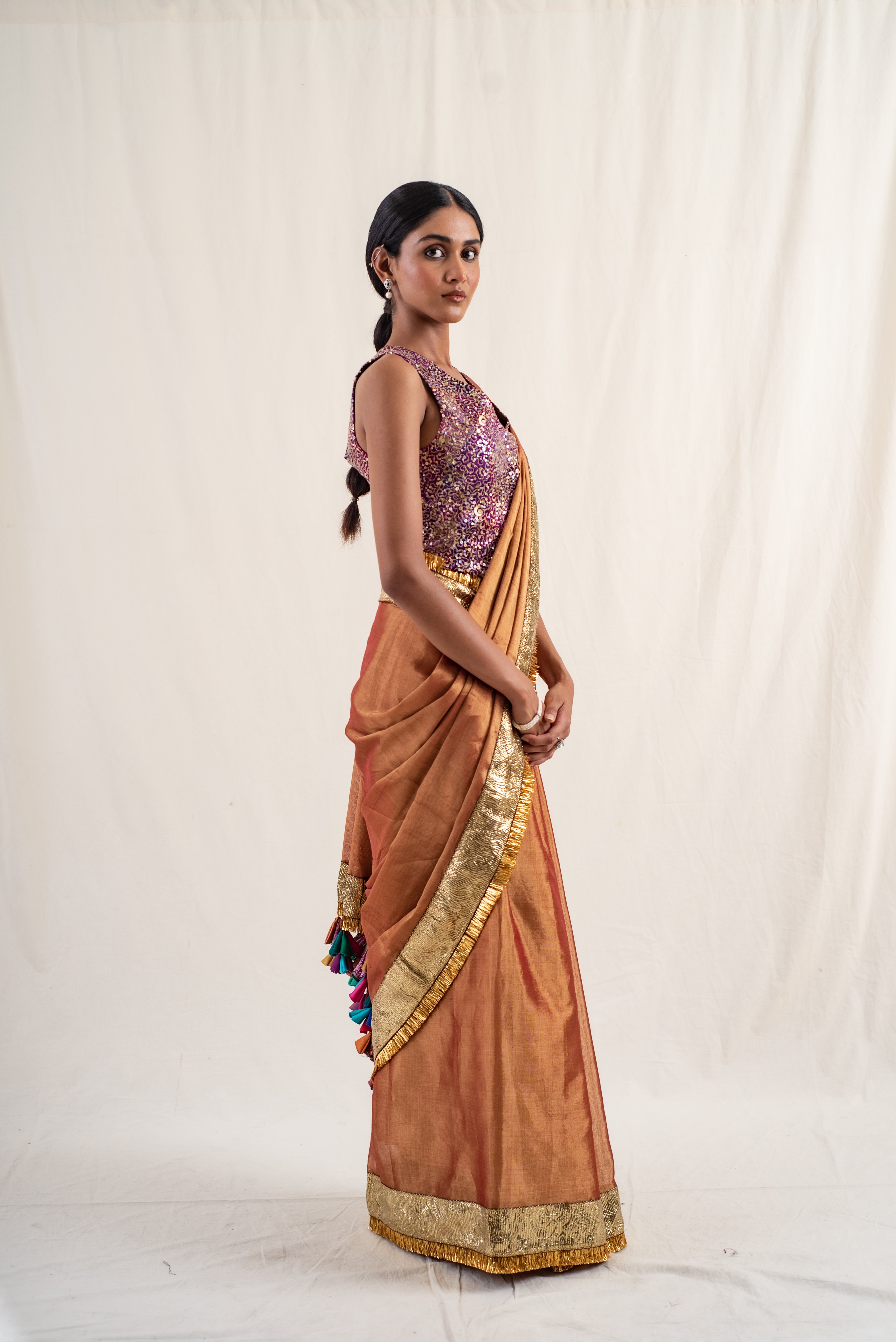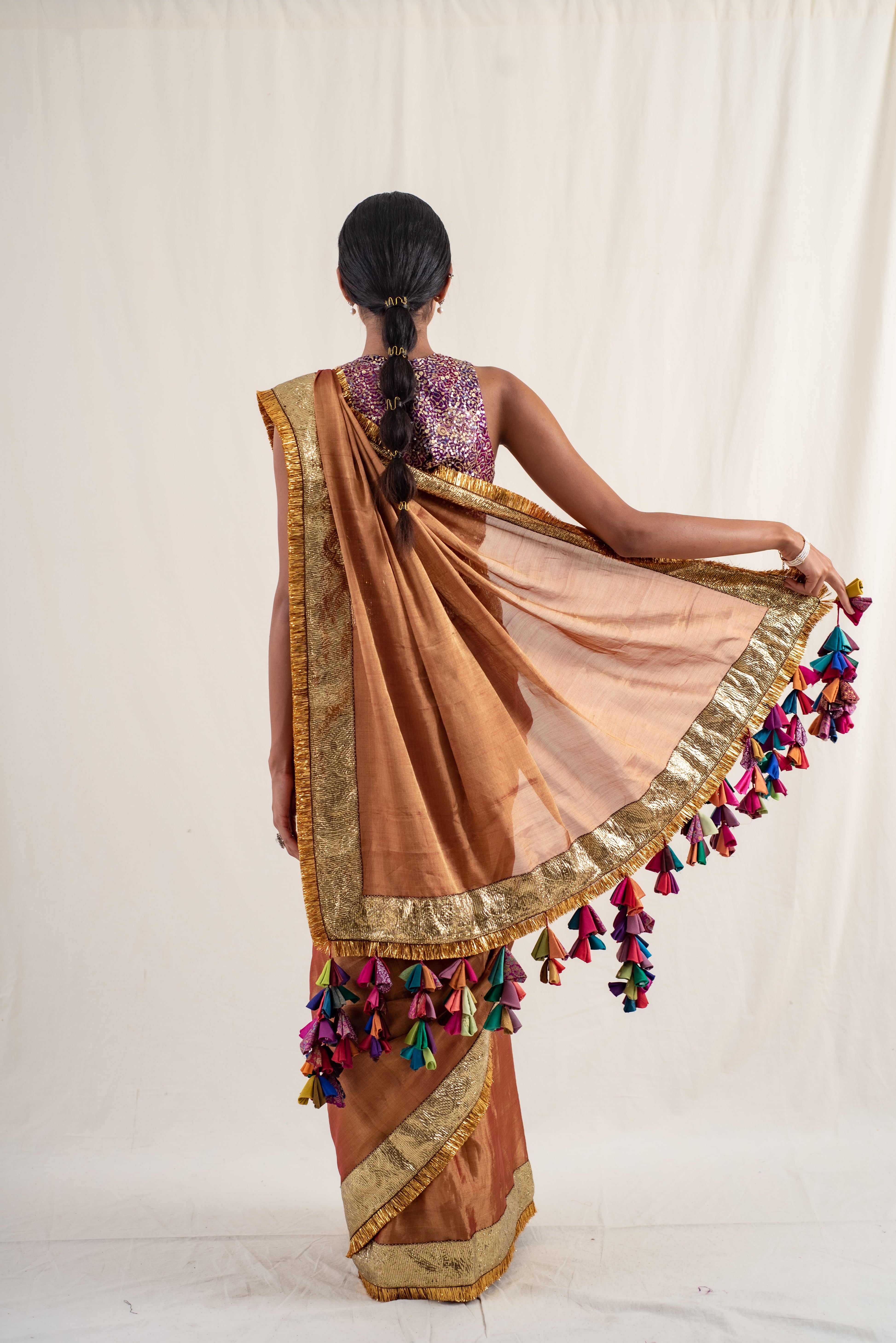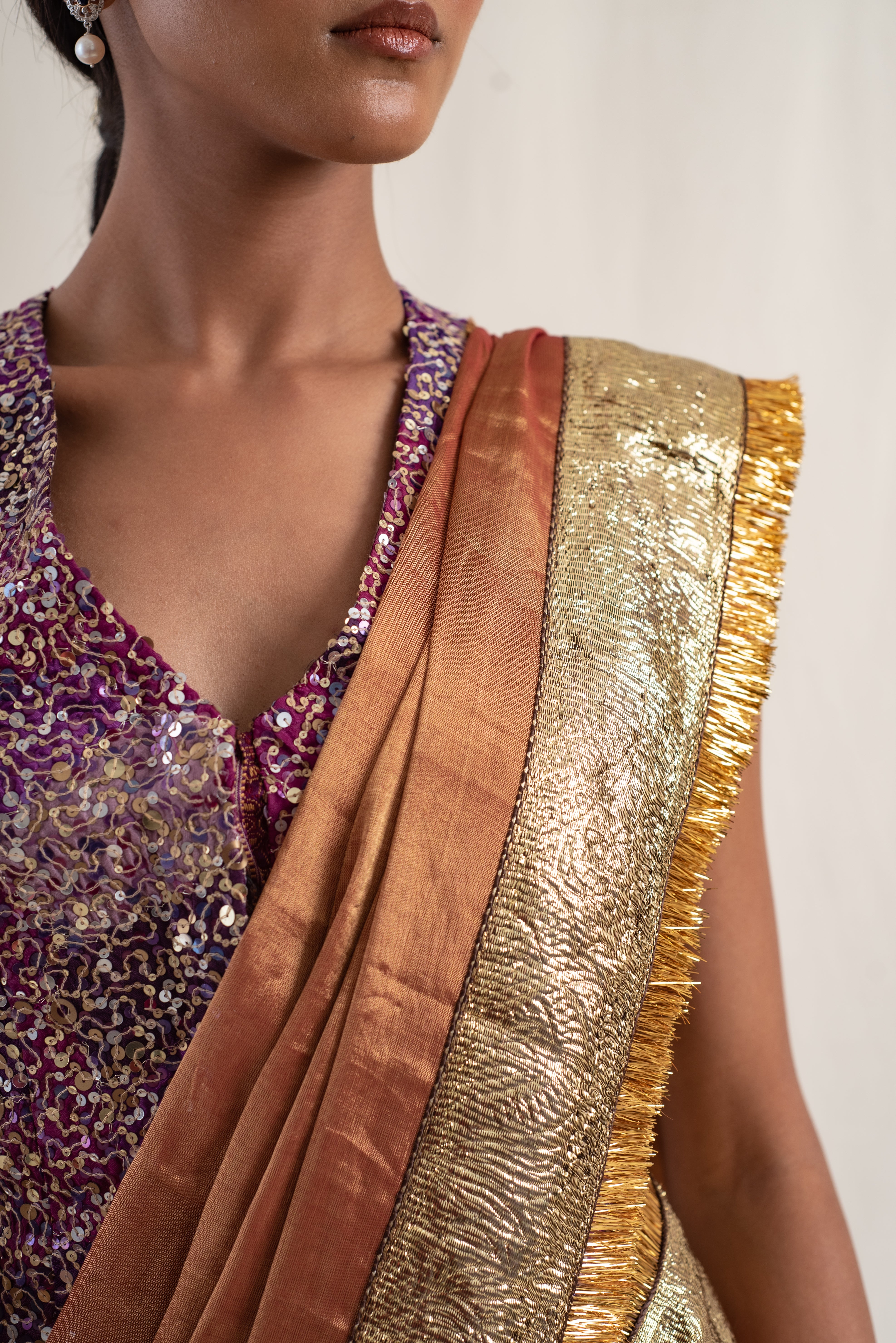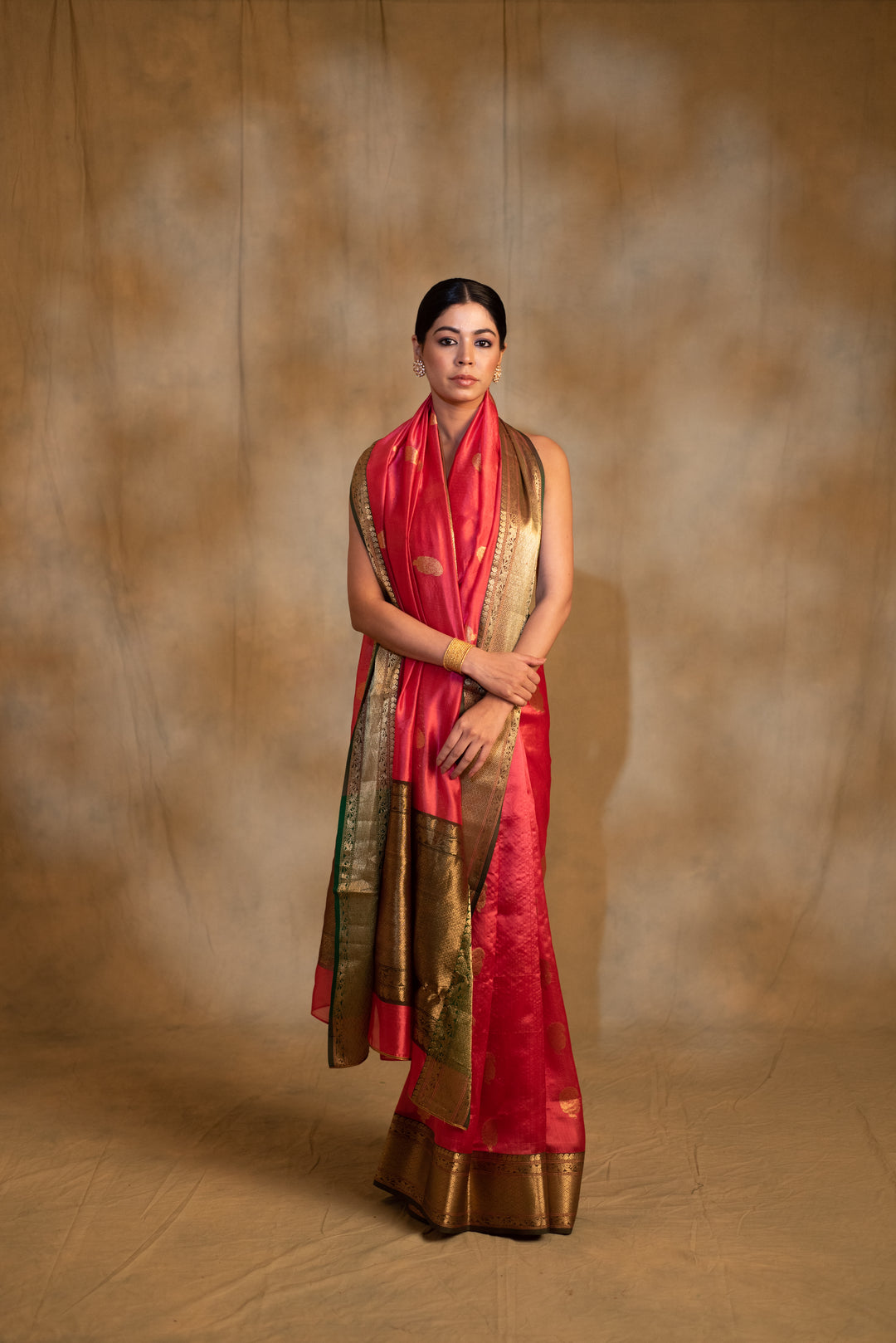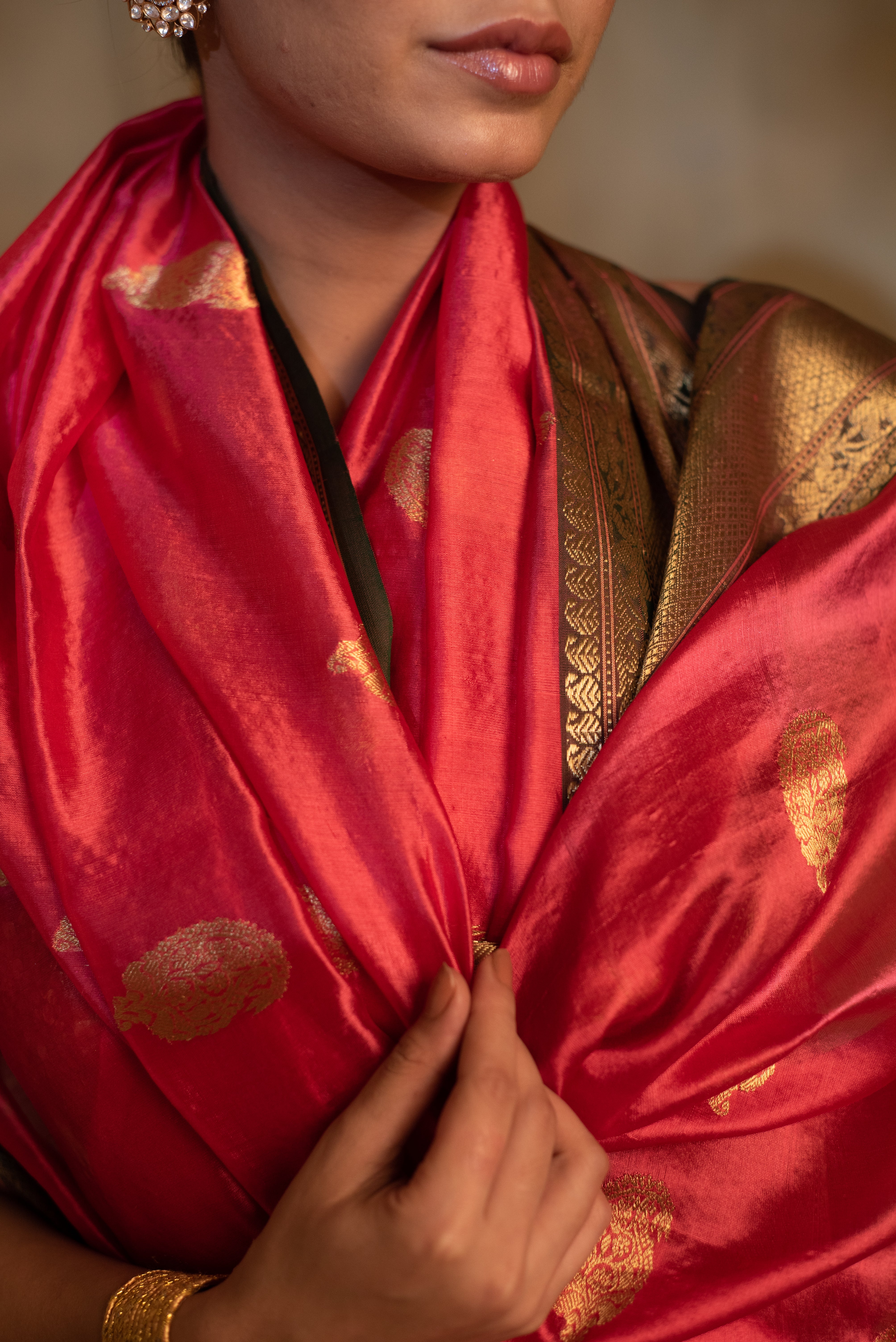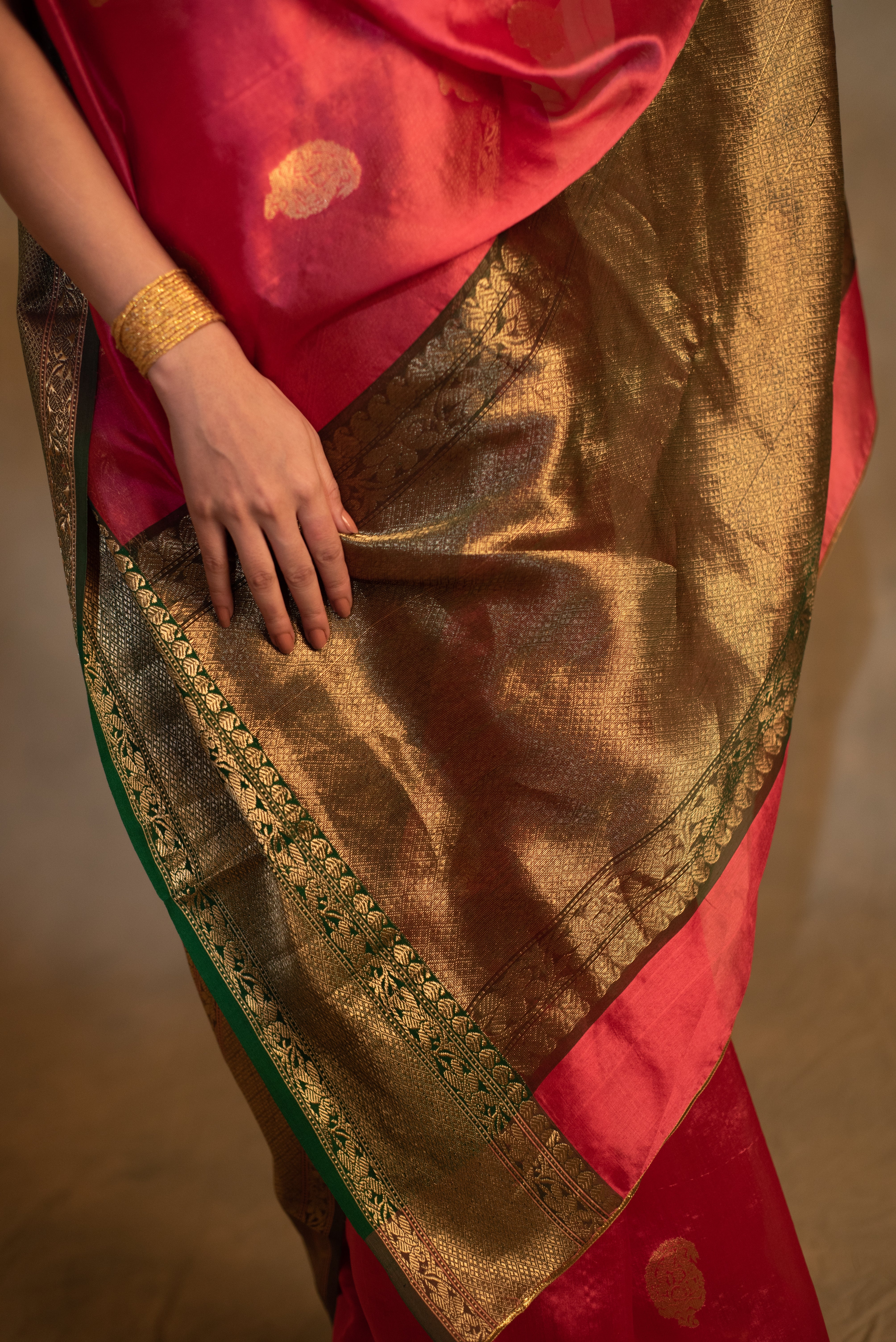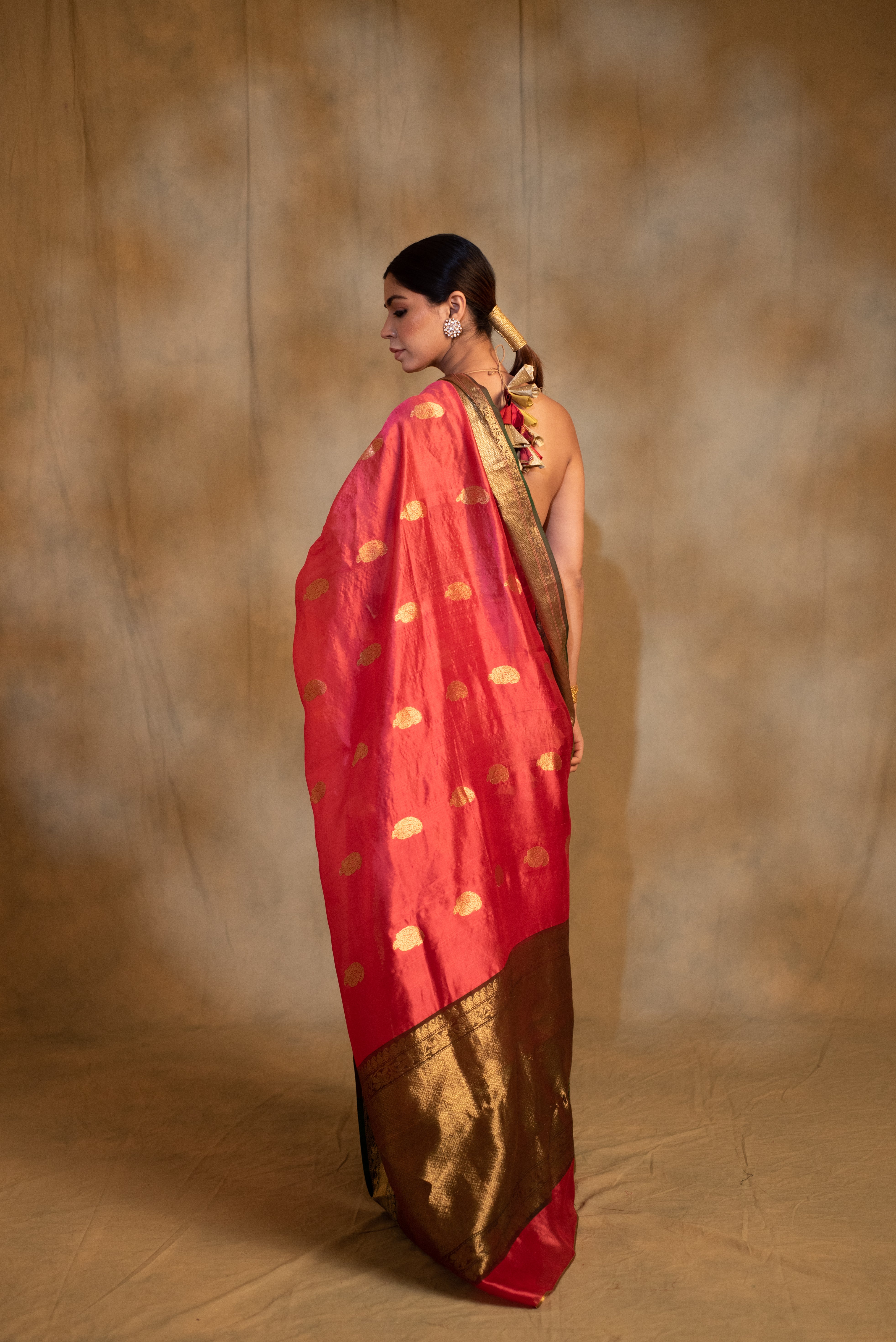Buy Red Chanderi Saree Online
Buy Red Chanderi Saree Online
Historical Significance of a Chanderi Saree
Chanderi fabric was woven manually earlier for kings. Pagdis were for kings, and the dhammas were made of Chanderi fabric. Chanderi fabric has its origins in the town of Chanderi in Madhya Pradesh, which is also attested in historical and political archives. Although historians and textile scholars keep the flame alive about the fact that the antiquity of Chanderi dates back to before the Rig Veda and the Mahabharata, its historical record can be traced to as early as the 13th century C.E., when a group of weavers migrated from the Malwa-Bundelkhand belt to Chanderi.
Today, it is made with a silk warp and a silk weft to create a more luxurious piece. Every single loom producing the fabric is a handloom, which can take a minimum of three days or up to 15 days, depending on its detailing. Chanderi exudes subtle shine, understated sophistication, and, more significantly, lightness, about which village weavers take a deep pride and claim “bunni hui hawa.”
Madhya Pradesh was a traditional weaving area, and Chanderi of Madhya Pradesh began to make a name in the 11th century. This was the same time that it had become one of the great trade regions of India due to its proximity to the ancient ports of Gujarat, Malwa, Mewar, Central India, and Deccan. The fabric is also referred to in a number of mythological and historical texts. The Mahabharata mentions that Chanderi fabric was brought in by Shishupal, the cousin of Lord Krishna. According to the Maasir-i-Alamgiri, Emperor Aurangzeb is reported to have commanded that a golden and silver embroidered cloth be presented as a Khilat (ceremonial garment offered to a superior).
Today, it is made with a silk warp and a silk weft to create a more luxurious piece. Every single loom producing the fabric is a handloom, which can take a minimum of three days or up to 15 days, depending on its detailing. Chanderi exudes subtle shine, understated sophistication, and, more significantly, lightness, about which village weavers take a deep pride and claim “bunni hui hawa.”
Madhya Pradesh was a traditional weaving area, and Chanderi of Madhya Pradesh began to make a name in the 11th century. This was the same time that it had become one of the great trade regions of India due to its proximity to the ancient ports of Gujarat, Malwa, Mewar, Central India, and Deccan. The fabric is also referred to in a number of mythological and historical texts. The Mahabharata mentions that Chanderi fabric was brought in by Shishupal, the cousin of Lord Krishna. According to the Maasir-i-Alamgiri, Emperor Aurangzeb is reported to have commanded that a golden and silver embroidered cloth be presented as a Khilat (ceremonial garment offered to a superior).
Why Choose Priyanka Raajiv's Red Chanderi Saree?
This collection of red sarees for women online is a labour of pure intent and true artistry. Priyanka Raajiv’s red Chanderi saree combines heritage weaving with minimal elegance and timeless charm. It is designed for women who appreciate tradition but express it in their own unique way. Here’s what sets it apart:
1. Celestial Chanderi Weave
Priyanka Raajiv Chanderi sarees are heralded for their feather-lightness—handwoven textures that are known throughout India as "woven air." The sheer fabric has a sumptuous drape and floats upon one's body as if it were nothing at all.
2. Intentionally Chosen Fabrics
Each artistically spun saree comes either in pure silk or in combinations of silk and cotton that impart a secondary silken and flowing fall. The after-finish in the finest fabric illuminates delicate light to create pieces that can be equally fine for a laid-back afternoon or an evening gala.
3. Artisan Details
All sarees are defined with incredible artisan details. Tiny woven butis, impeccably woven zari borders, and delicately woven motifs. The touch of artisans ensures that traditional methods are preserved, and, additionally, each garment has a charm of its own—each becomes an intimate representation of artistic heritage.
4. Special Small-Batch Makes
These sarees are not mass-produced; they are made through slow production methods, with many designers specialising in small-batch creations. Purchasing one of these garments is a meaningful investment, as it embodies sustainability, craftsmanship, and style. These sarees are heirlooms, designed to last forever, rather than being disposable items that are worn briefly and then discarded.
1. Celestial Chanderi Weave
Priyanka Raajiv Chanderi sarees are heralded for their feather-lightness—handwoven textures that are known throughout India as "woven air." The sheer fabric has a sumptuous drape and floats upon one's body as if it were nothing at all.
2. Intentionally Chosen Fabrics
Each artistically spun saree comes either in pure silk or in combinations of silk and cotton that impart a secondary silken and flowing fall. The after-finish in the finest fabric illuminates delicate light to create pieces that can be equally fine for a laid-back afternoon or an evening gala.
3. Artisan Details
All sarees are defined with incredible artisan details. Tiny woven butis, impeccably woven zari borders, and delicately woven motifs. The touch of artisans ensures that traditional methods are preserved, and, additionally, each garment has a charm of its own—each becomes an intimate representation of artistic heritage.
4. Special Small-Batch Makes
These sarees are not mass-produced; they are made through slow production methods, with many designers specialising in small-batch creations. Purchasing one of these garments is a meaningful investment, as it embodies sustainability, craftsmanship, and style. These sarees are heirlooms, designed to last forever, rather than being disposable items that are worn briefly and then discarded.
Discover Our Signature Red Chanderi Sarees
Each piece in this collection balances heritage and modern elegance. Hand-woven by artisans in Chanderi, these sarees are created using traditional methods of weaving, centuries of history, intended motifs, zari borders, and extremely lightweight fabric, all of which create modernity. Ideal for rituals, intimate celebrations, or using art every day, the sarees could each be vintage someday.
Kaiya – Red Silk Chanderi Saree
With this red silk Chanderi saree, you can enjoy timeless elegance with artisanal refinement. The drape has tonal Mashru silk borders that frame the drape as well as a shiny gold palla. Handwoven using traditional Chanderi weaving styles, the sarees are featherweight and drape beautifully when worn, allowing for comfort and grace when heritage meets modern artfulness.Omya – Red Silk Chanderi Saree
A handwoven satin silk Chanderi saree in red, with fine gold butis scattered on the body. It weighs almost nothing, is woven using the traditional Chanderi technique, offers a soft sheen to look beautiful when draped, and can be worn on both celebratory and formal occasions.Sora – Red Silk Chanderi Tissue Saree
This vermilion red silk Chanderi saree carries delicate floral butis, a reverse scalloped border, and an elaborate gold palla. It bestows a graceful fall and refined finish, made meticulously by hand in the venerable Chanderi wear, and is hence one step up from regular attire for formal events.What Makes Red Coloured Chanderi Sarees Special?
Priyanka Raajiv's Chanderi sarees possess a legacy spirit that is in the making. All our garments are handloomed by artisans in small runs using traditional techniques to ensure a smooth, light drape. The intricate designs, luxurious zari borders, and satin-like finishes have been reimagined to embed culture and history for the wearer today. Priyanka places special focus on exclusive, comfortable, and eternally poised clothing.
- Light as a Feather: Intricately woven, these sarees are delicate yet elegant. A beauty not to be weighed down.
- Heritage in Every Thread: Every hallmark, whether it be zari, motif, or weave, is embedded with the history of Chanderi weaving traditions, viewed through a modern lens.
- Intimate and Exclusive: Limited editions of these sarees are more than just garments and fashion scarcely worn: these are collectable embodiments of sustainable craftsmanship and design principles.
How to Style Your Red Colour Chanderi Saree?
The myriad shades of red echo celebration, nurture traditions, and nourish modern self-expression. The red Chanderi saree carries with it a balance of imposing discipline and creativity in styling.
- Day Events: The blouse would be best complemented by colours muted to pastels, in beige, stone, or soft gold. Jewellery is silver or pearl, stunning in its understatement.
- Evening & Weddings: Avail of the richness of red using statement earrings, glowing metallic heels, and crimson lips. A contrasting clutch in forest green or antique gold completes the festive look.
- Tailored Drapes: If you’re going for a mixed look, you can also wear a tailored shirt—structured sleeves or asymmetrical hemline—and then delicately, you can even cinch your waist with a simple belt. The shape can stay traditional, but your attitude is contemporary.
Perfect Occasions for Styling Red Colour Chanderi Saree
This red Chanderi saree is not only beautiful; it's also very timeless. Its traditional design will never fail you, and it's so versatile; you'll never lack the opportunity to wear it. And to complete it, you accessorise with gorgeous stays and diamond accessories, perhaps even unique family heirloom items, to keep it looking casual.
At Festivals — A festival is a place of celebration and tradition; an off-the-rack-easy-breezy red Chanderi saree is how you would define that saying. The luxe Chanderi fabric will reflect the lights of Diwali, and the richness of red will signify the devotion at Durga Puja, as well as the elegance of Karva Chauth. There is something special about the colour red, and it holds meaning and existence to devotion and celebration—especially on evenings filled with ceremonies, lights, and family!
For Wedding Events — Red Chanderi sarees exude a festive yet dignified charm, making them perfect for anyone at a wedding celebration, whether you're the bride's sister, a bridesmaid, or a guest. For events like Mehendi and Sangeet, consider pairing your saree with a colorful blouse or bold accessories to balance its regal elegance with a touch of joy. As a guest, you’ll embody traditional, timeless beauty, allowing you to look graceful without drawing excessive attention. However, you will certainly make an impression in a red Chanderi saree.
For Cultural Events and Temple — A red chanderi sari steeped in Indian heritage makes it suitable for a great deal of events of cultural richness: Indian classical dance or music events, or even a trip to the temple. The colour red indicates respect and holiness. Chanderi is light and breathable, and it is delicate in its weave. It is traditional but not heavy, respectful but not out of date.
At Formal Events — Understated and graceful, a red Chanderi saree could be your statement at an art show, book reading, or an elegant soirée. Paired with minimalist jewellery (the necklace featured above being an excellent choice) and a soft-fitted blouse, a red Chanderi saree would gently carry off a style that is refined, culturally rich, and mellow: a very Indian representation set in a modern framework.
At Festivals — A festival is a place of celebration and tradition; an off-the-rack-easy-breezy red Chanderi saree is how you would define that saying. The luxe Chanderi fabric will reflect the lights of Diwali, and the richness of red will signify the devotion at Durga Puja, as well as the elegance of Karva Chauth. There is something special about the colour red, and it holds meaning and existence to devotion and celebration—especially on evenings filled with ceremonies, lights, and family!
For Wedding Events — Red Chanderi sarees exude a festive yet dignified charm, making them perfect for anyone at a wedding celebration, whether you're the bride's sister, a bridesmaid, or a guest. For events like Mehendi and Sangeet, consider pairing your saree with a colorful blouse or bold accessories to balance its regal elegance with a touch of joy. As a guest, you’ll embody traditional, timeless beauty, allowing you to look graceful without drawing excessive attention. However, you will certainly make an impression in a red Chanderi saree.
For Cultural Events and Temple — A red chanderi sari steeped in Indian heritage makes it suitable for a great deal of events of cultural richness: Indian classical dance or music events, or even a trip to the temple. The colour red indicates respect and holiness. Chanderi is light and breathable, and it is delicate in its weave. It is traditional but not heavy, respectful but not out of date.
At Formal Events — Understated and graceful, a red Chanderi saree could be your statement at an art show, book reading, or an elegant soirée. Paired with minimalist jewellery (the necklace featured above being an excellent choice) and a soft-fitted blouse, a red Chanderi saree would gently carry off a style that is refined, culturally rich, and mellow: a very Indian representation set in a modern framework.
Caring Tips for Red Chanderi Saree
A red Chanderi saree, one garment that is a fusion of traditions, sophistication, and the legacy of everyday fabric weaving. And maintaining its gloss, softness, and marvellous detail is comparatively easy with a bit of added care. Here are some ways to maintain your saree in that manner. To keep its delicacy and shine:
- Dry Clean Only and Separately: If the saree is decorated with zari or hand-embroidered embellishments, please dry clean it separately.
- Muslin Store: Try not to use plastic; using muslin will let the textile breathe.
- Flat & Folded: Hanging can cause the weave to stretch over time.
- Low Heat Ironing: Please use a cotton cloth between the iron and the saree to protect its good finish.
Conclusion
It is not just a piece of clothing; it is a legacy. One that has the remnants of loom-woven stories and brings to the woman of today, unapologetically, a vacancy of revelation. In Priyanka Raajiv’s red Chanderi saree, tradition marries texture, colour finds character, and occasion finds meaning. This is a saree to wear, to remember, and to bequeath.
